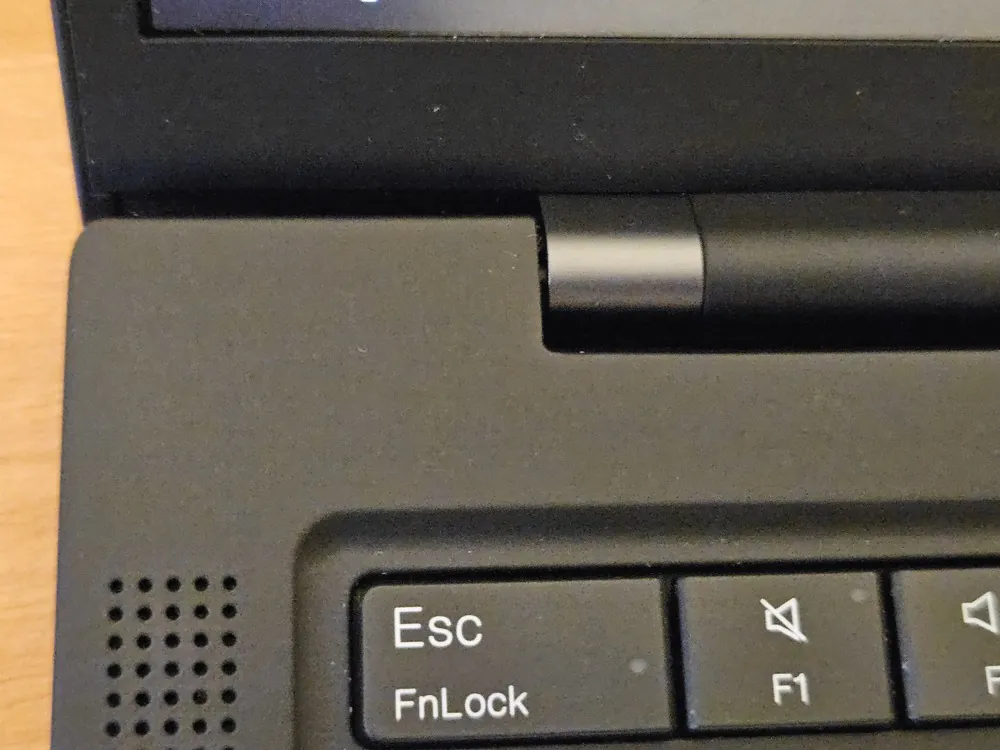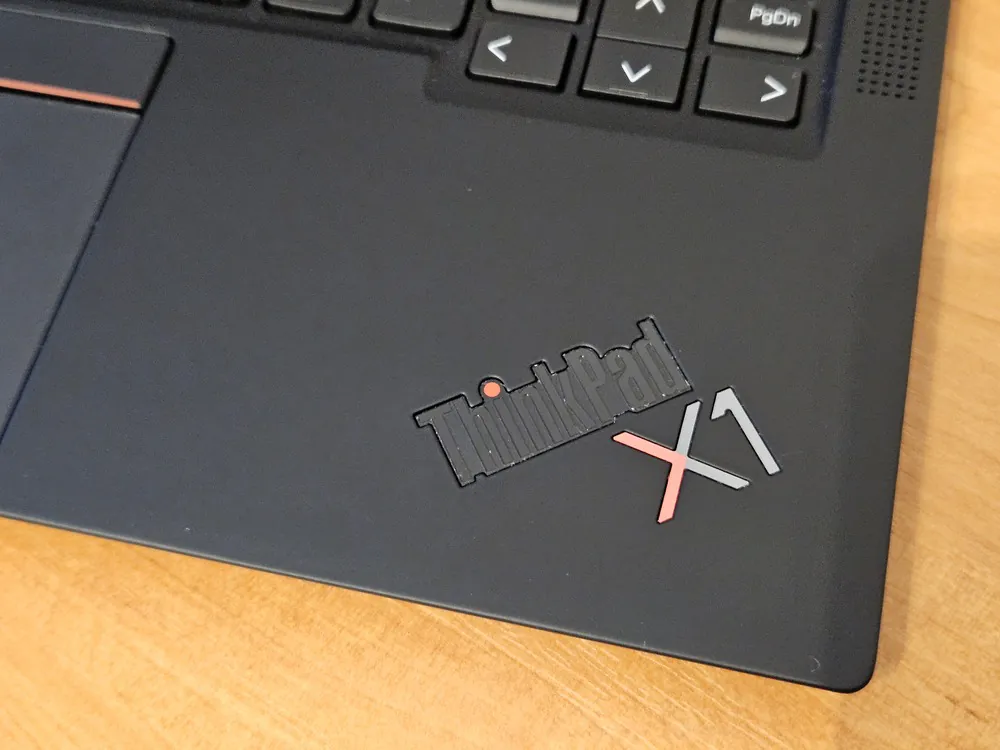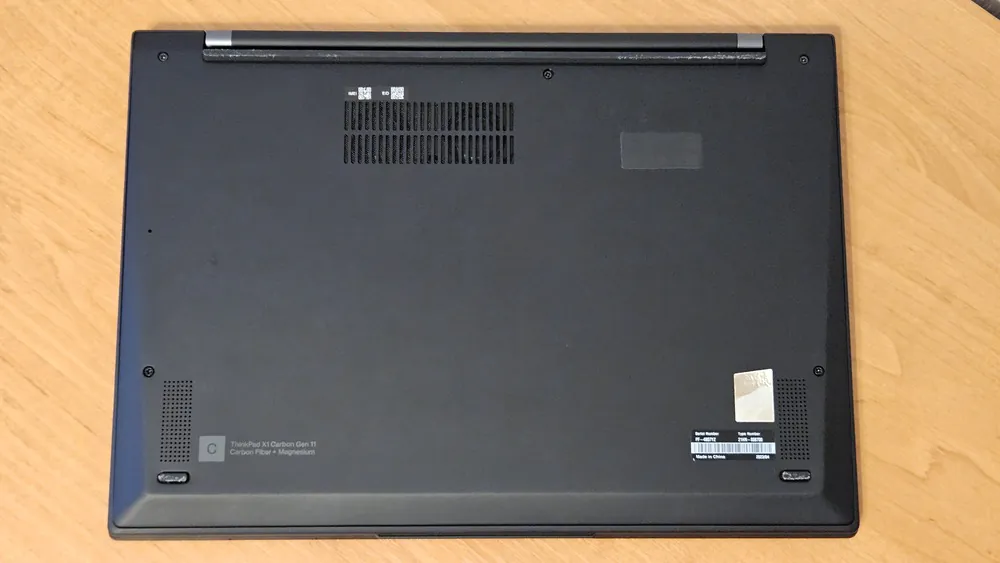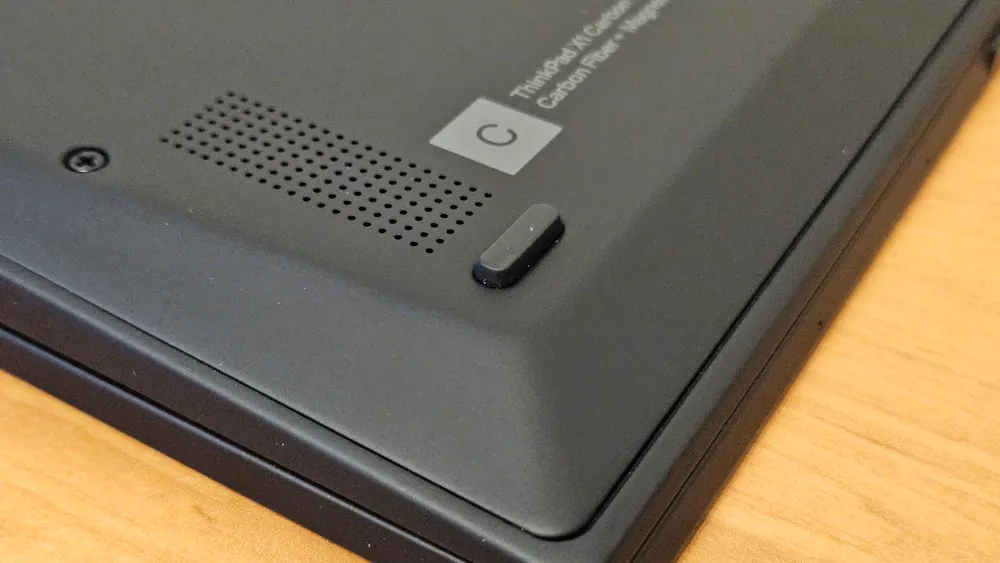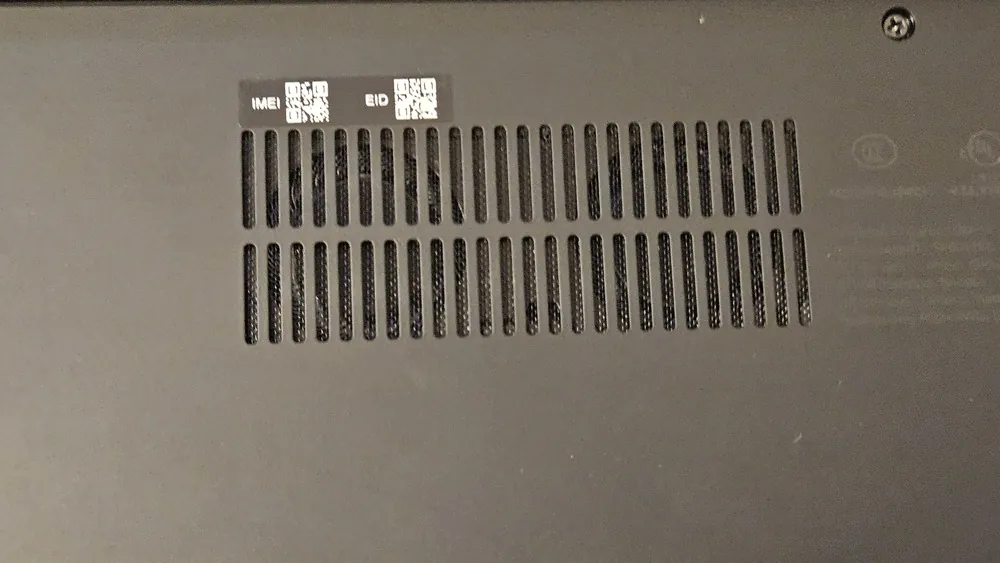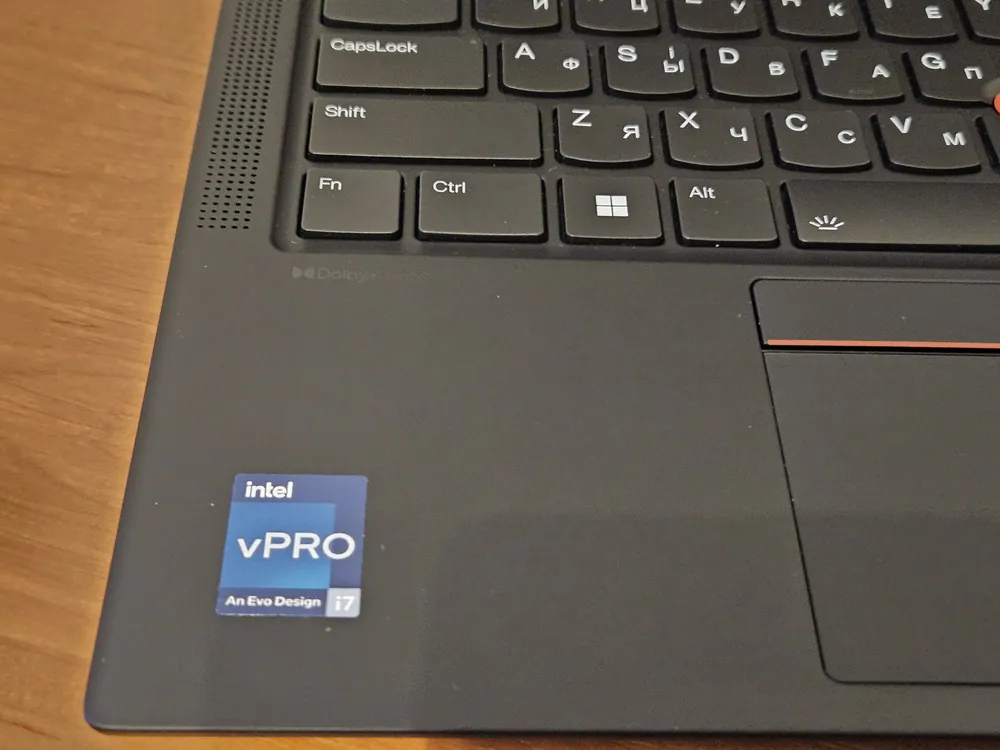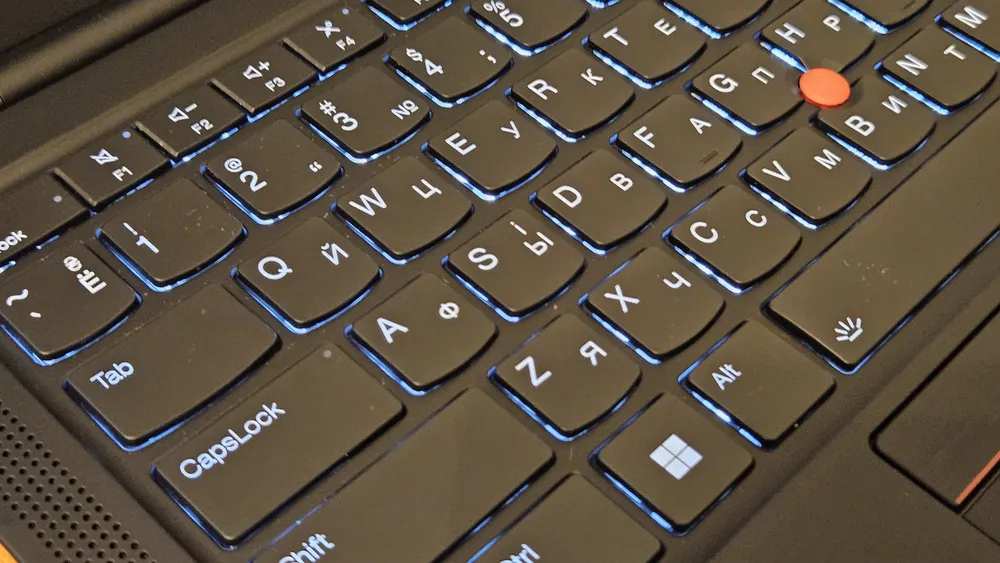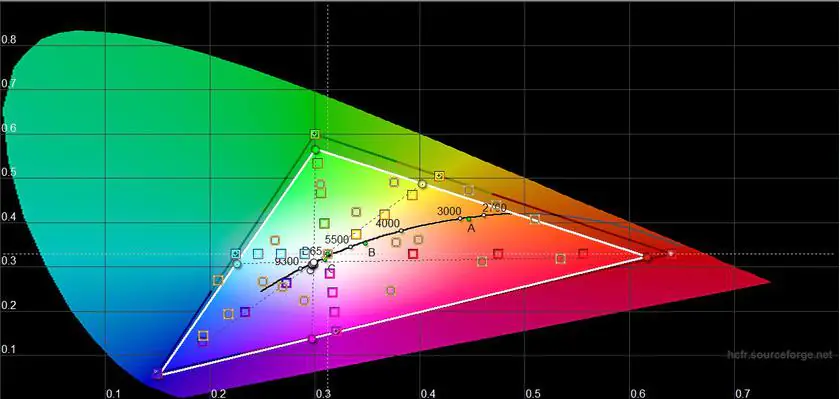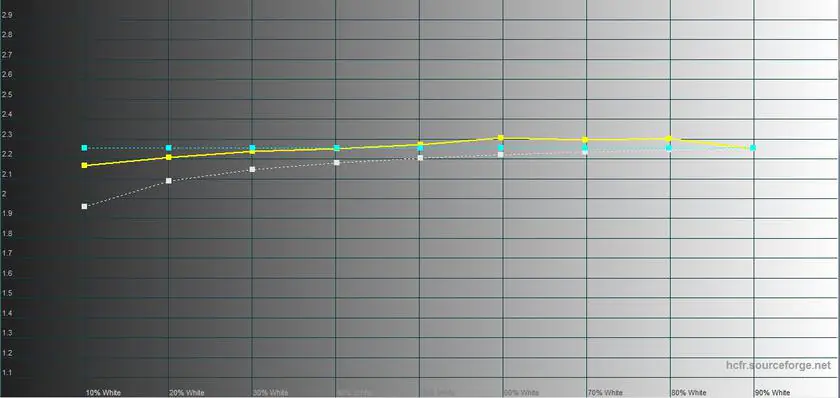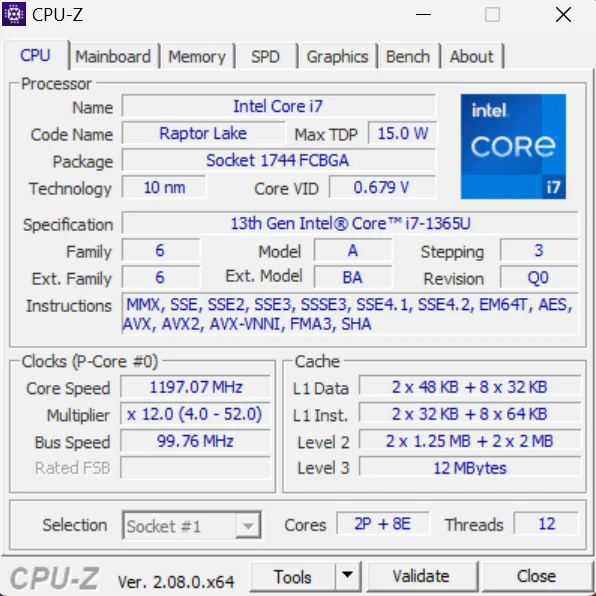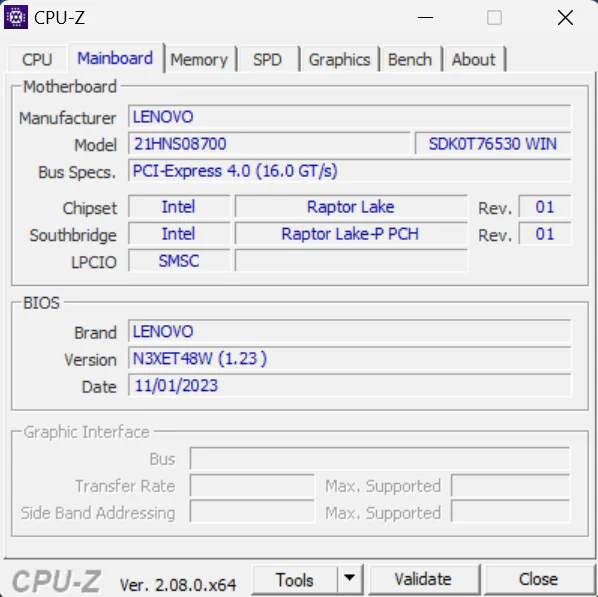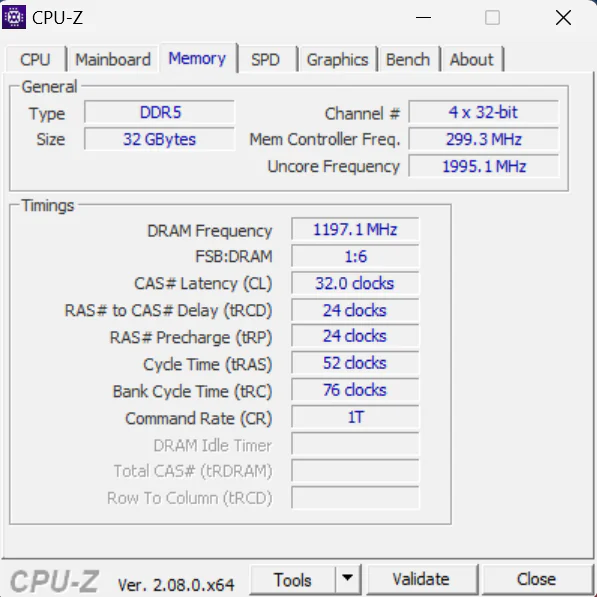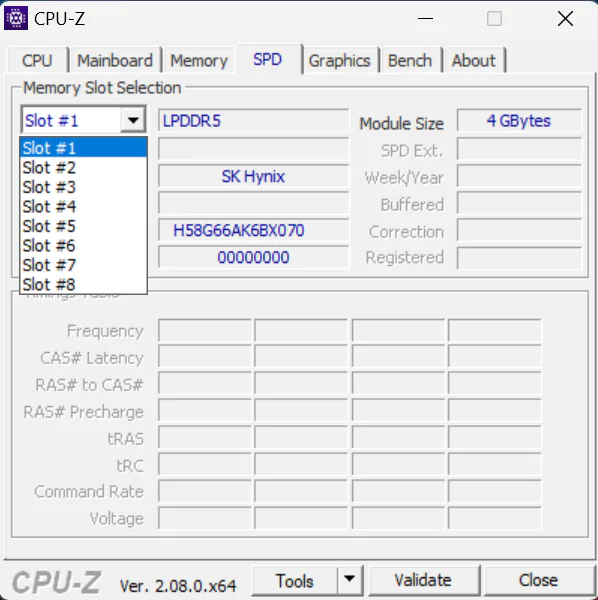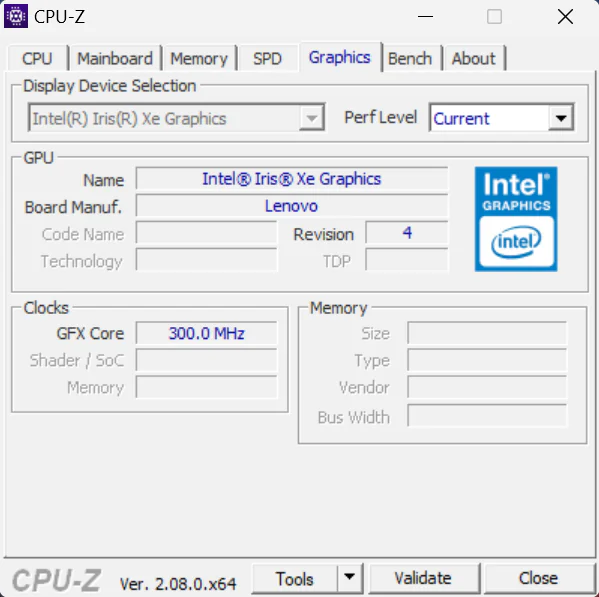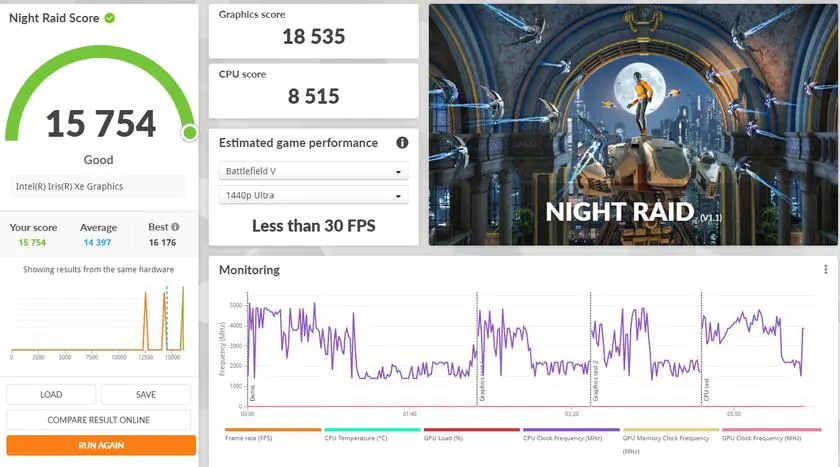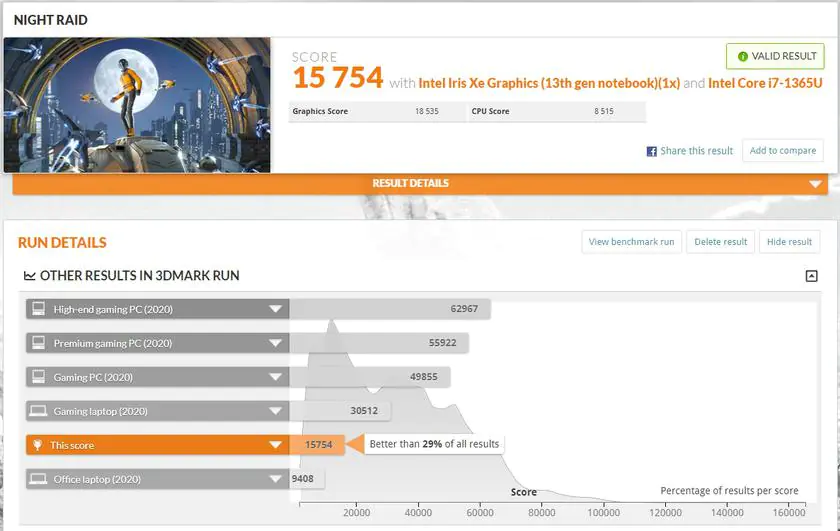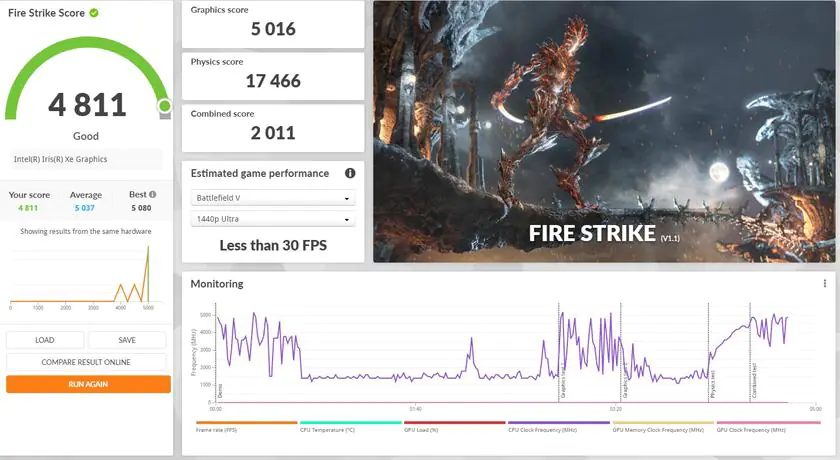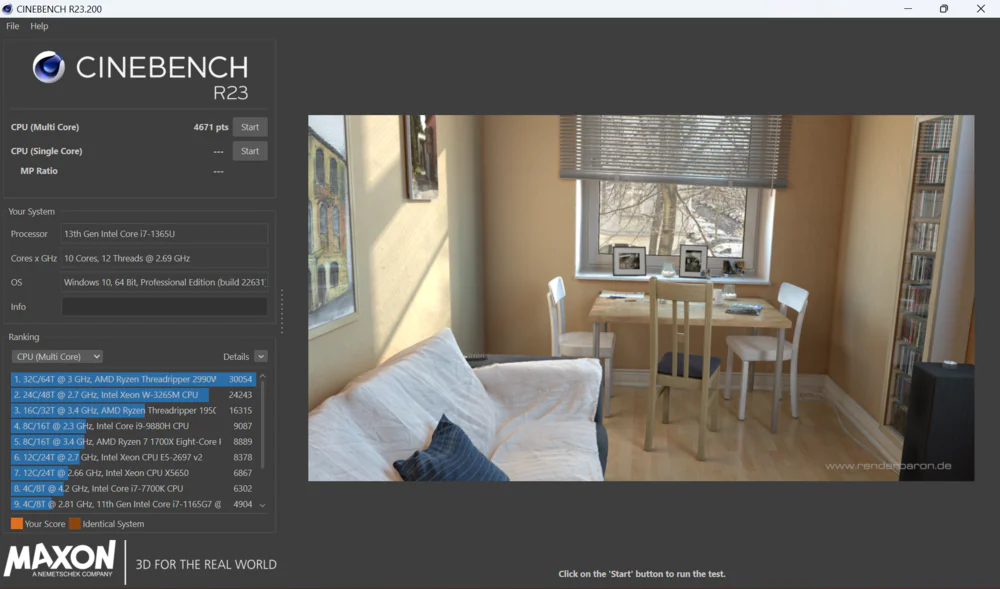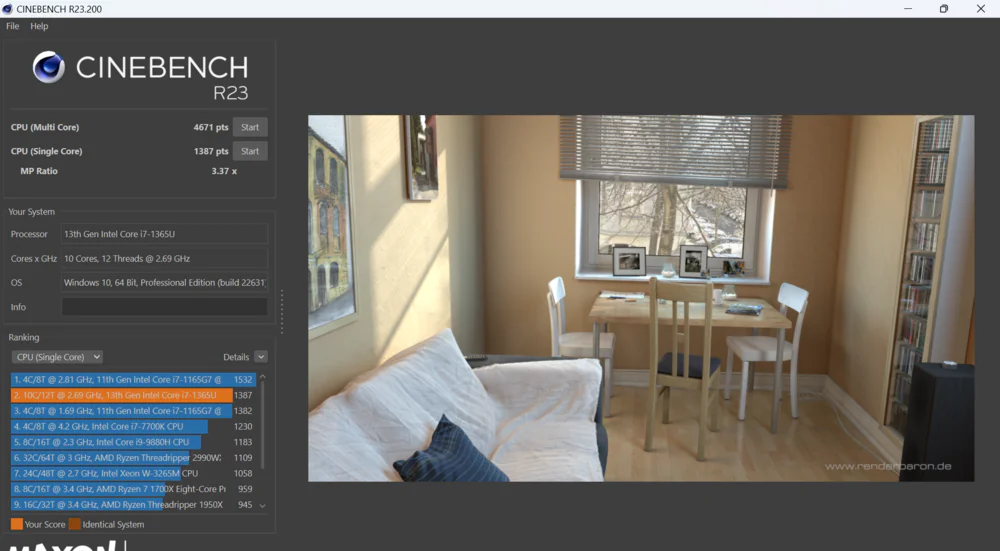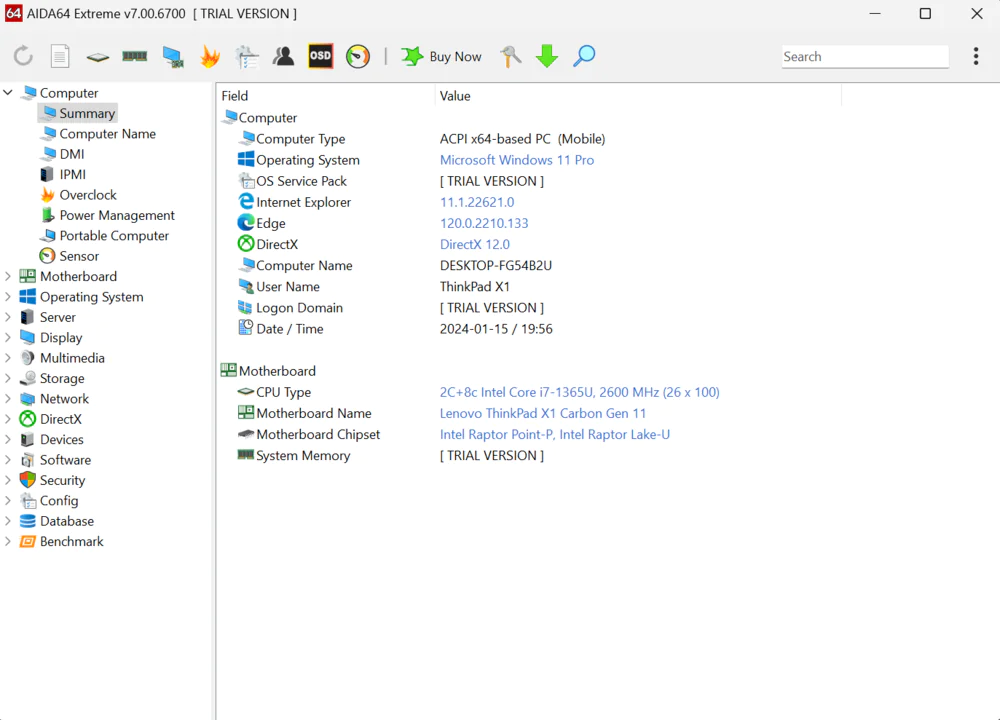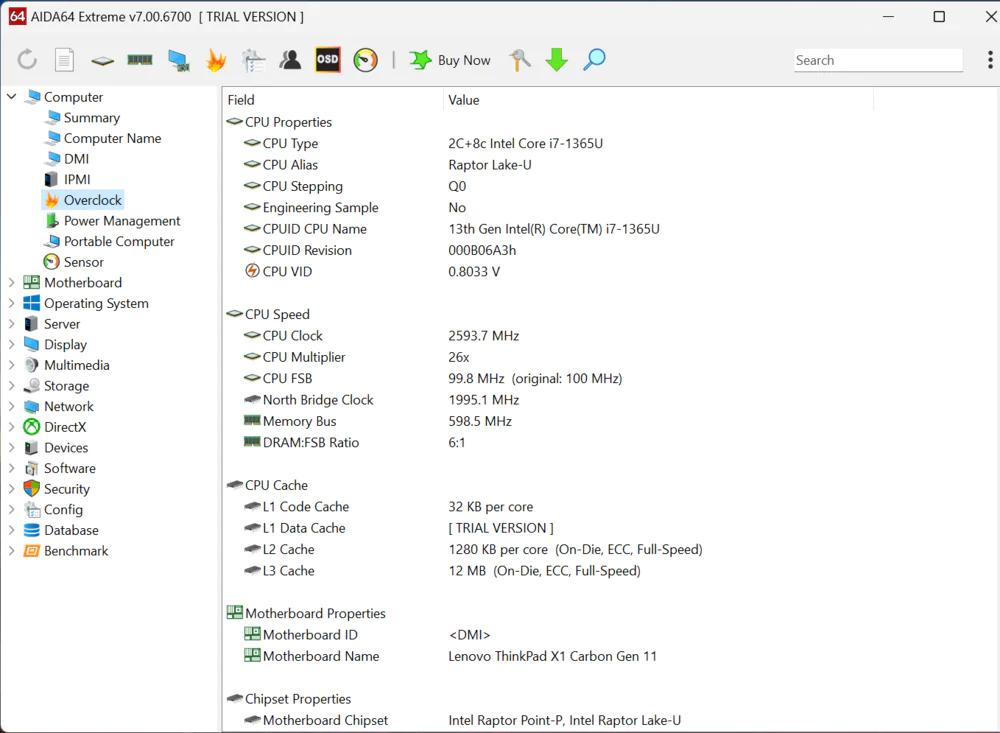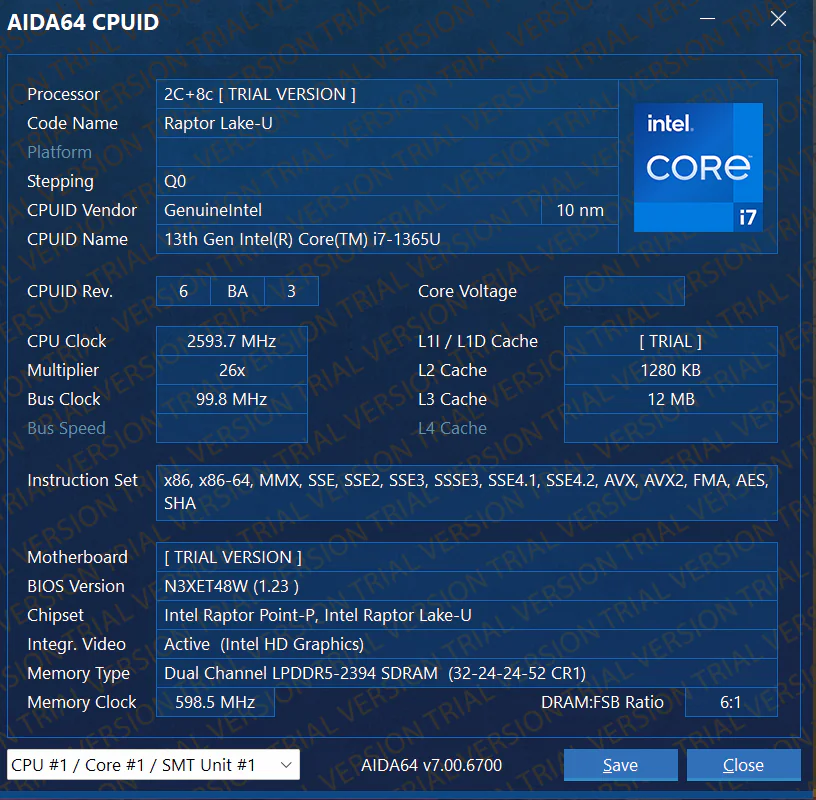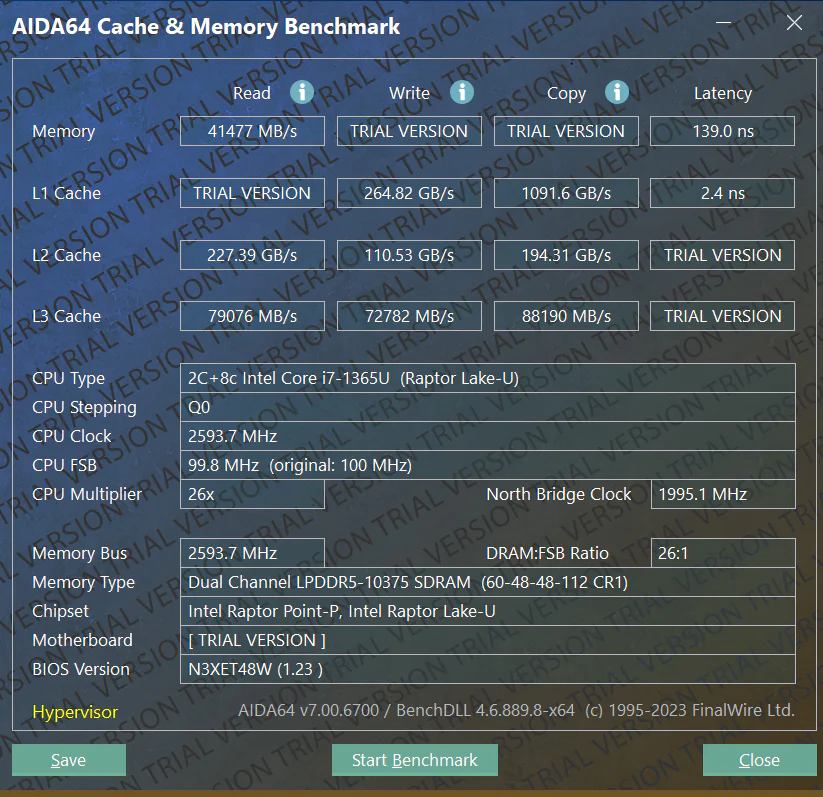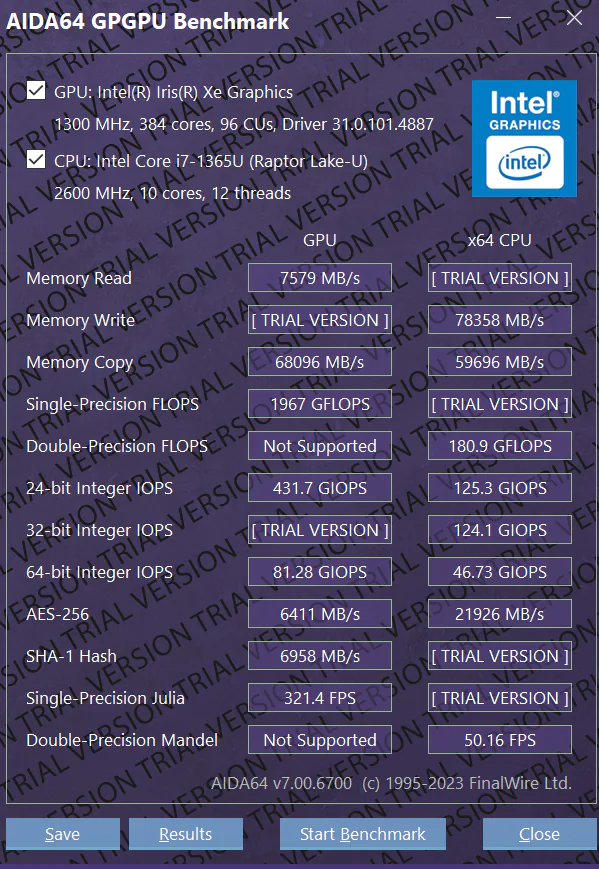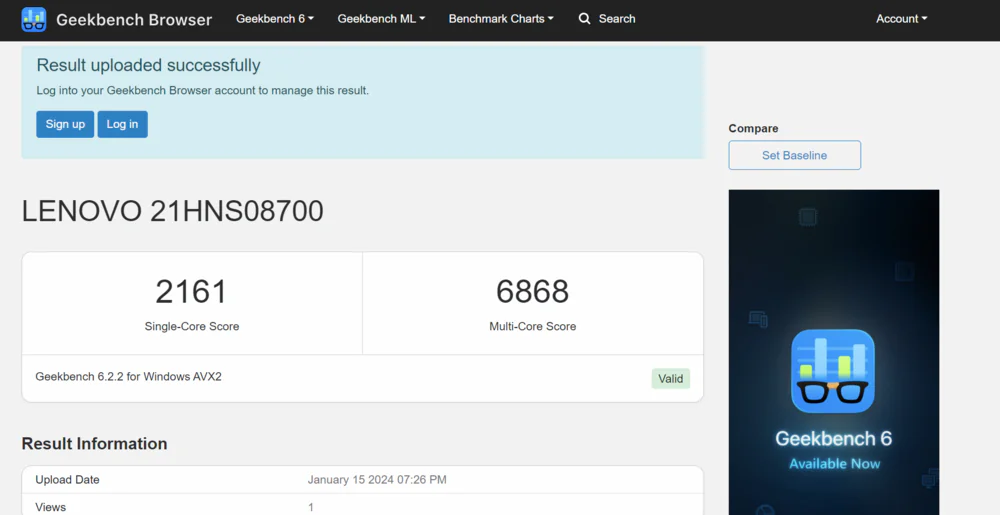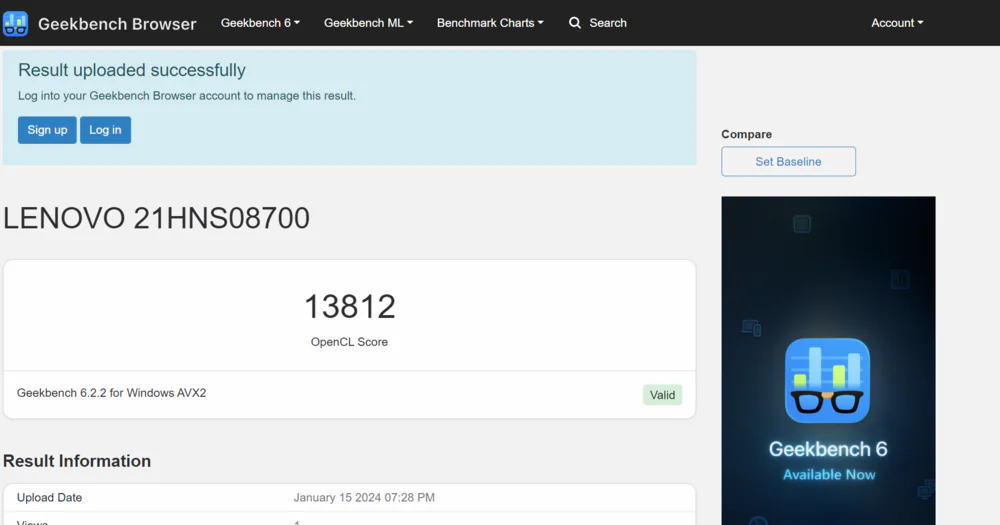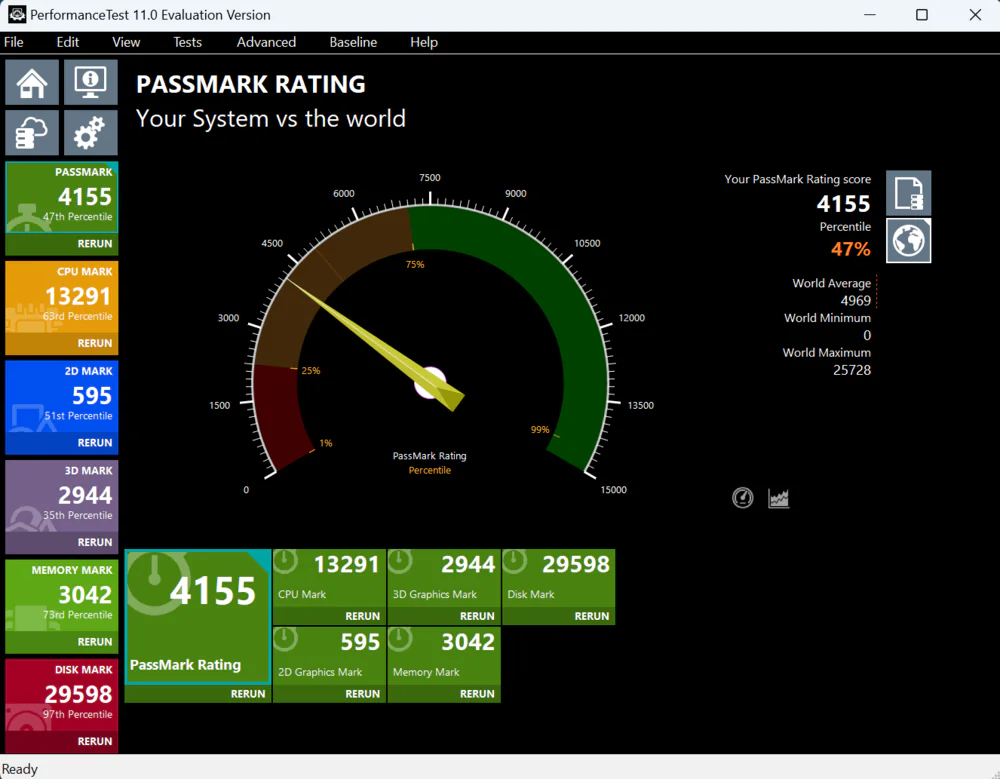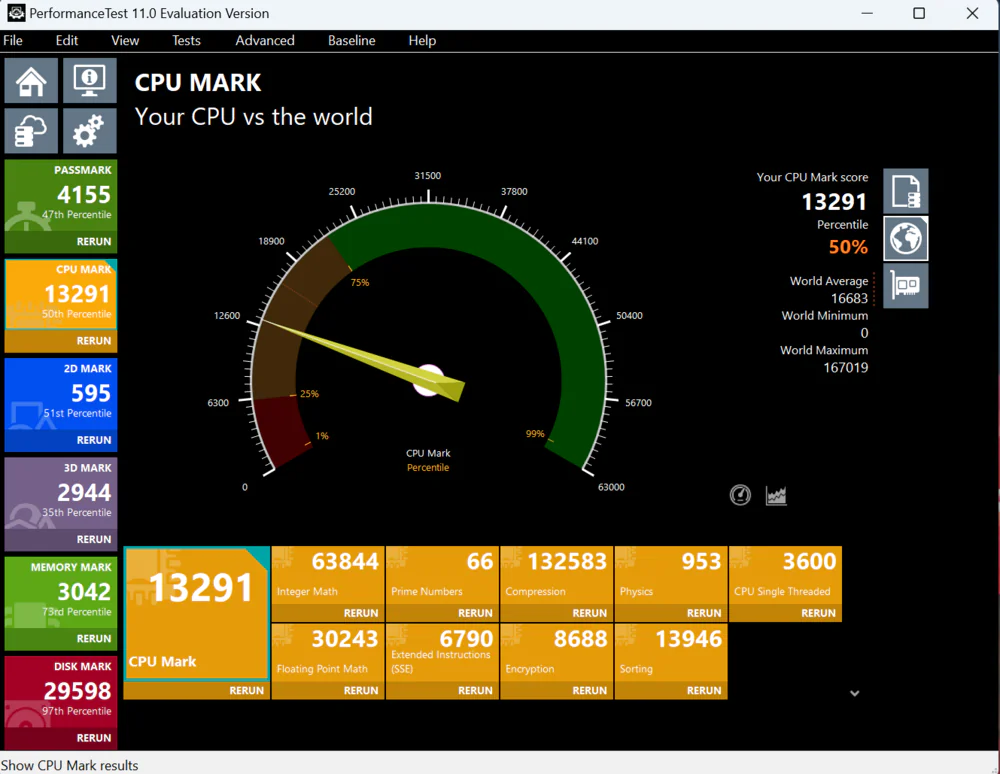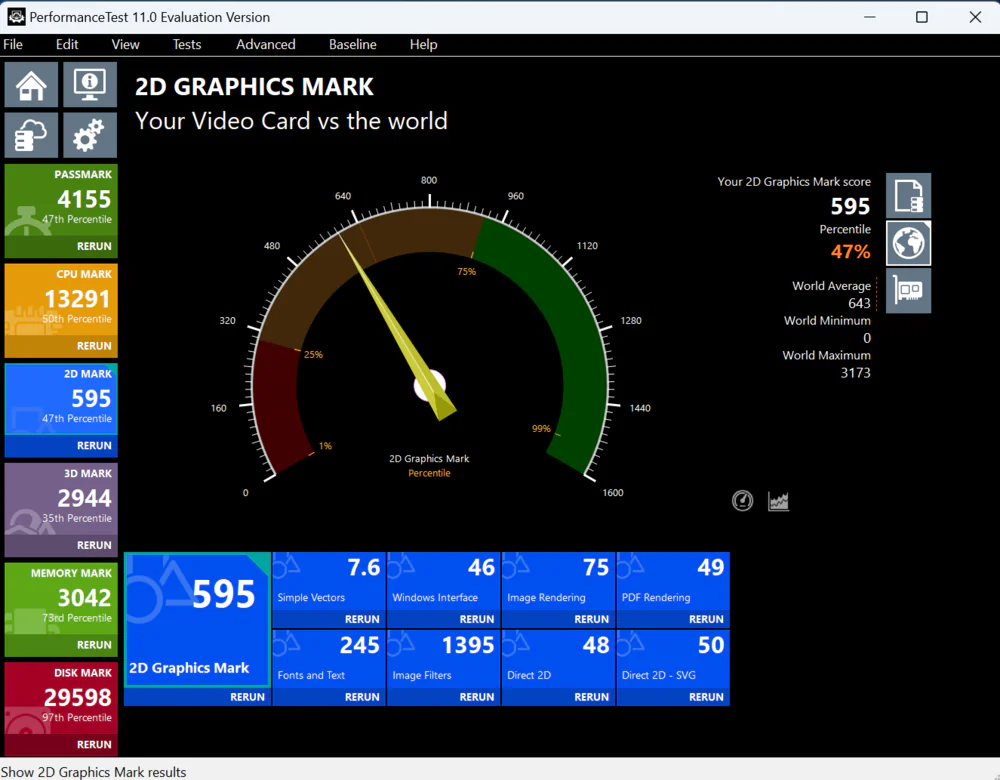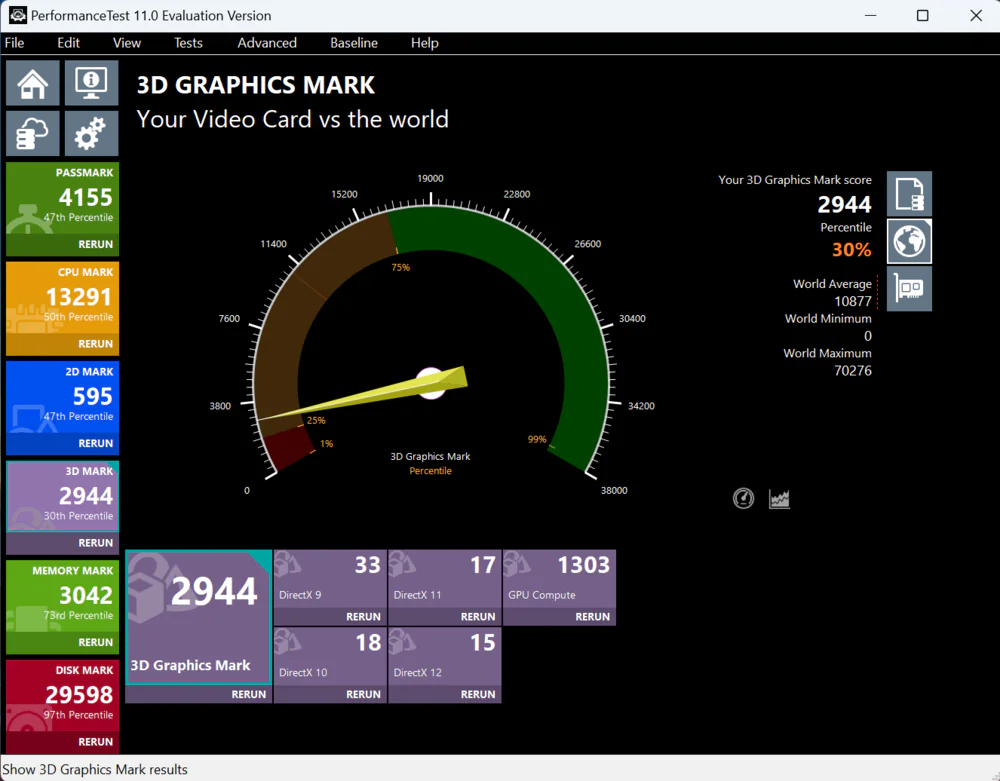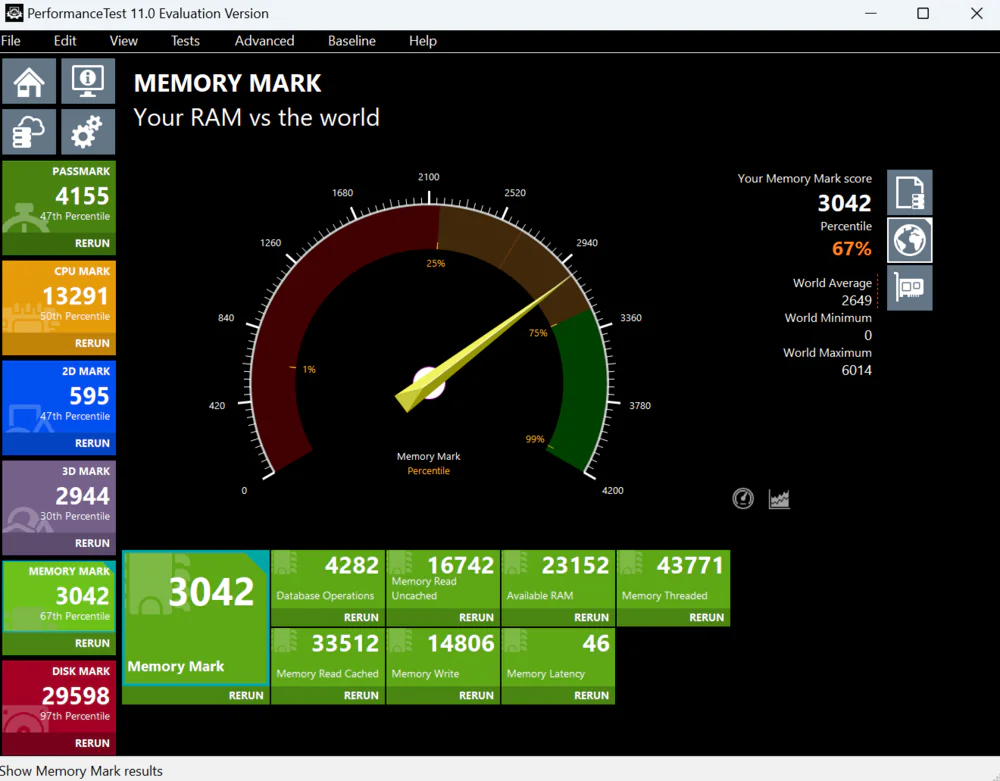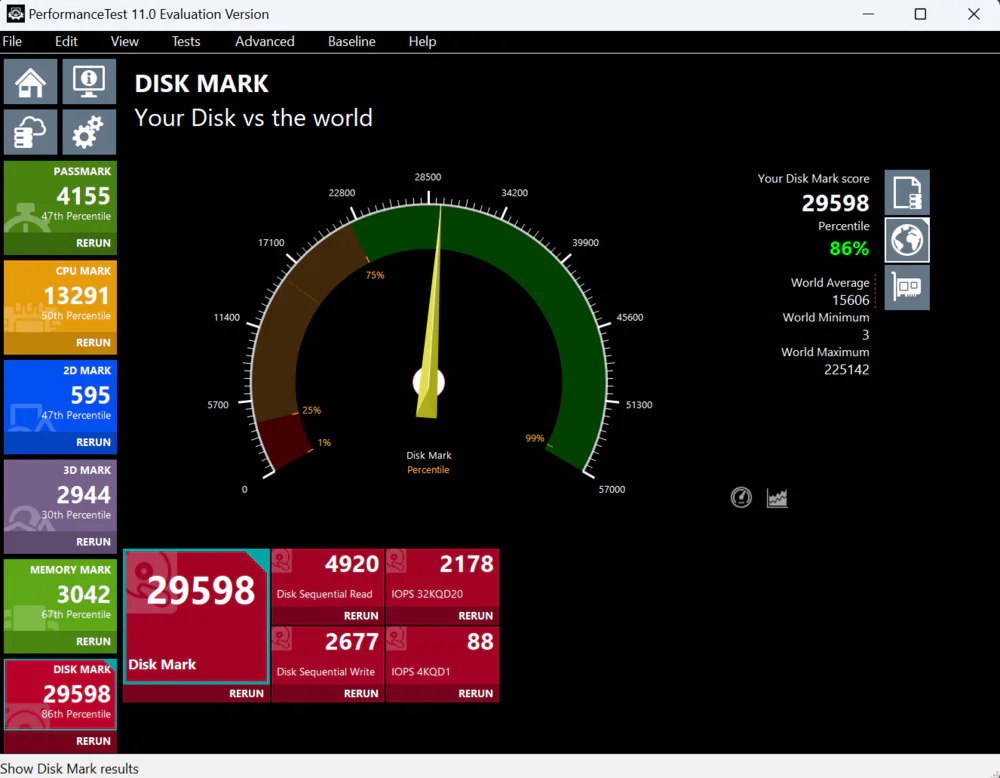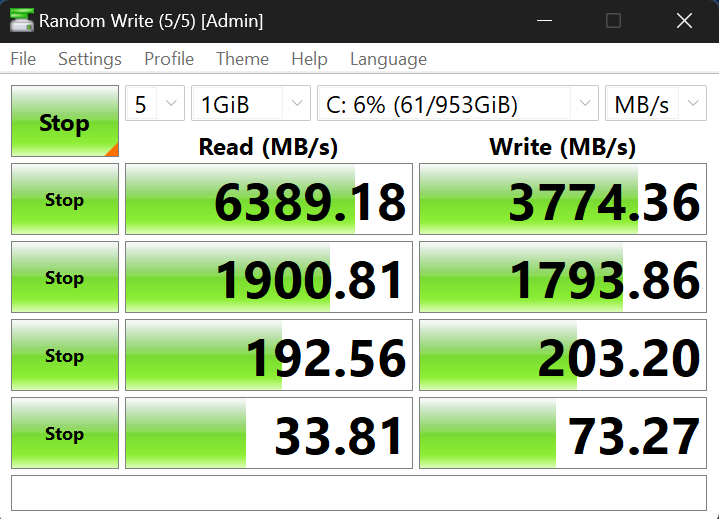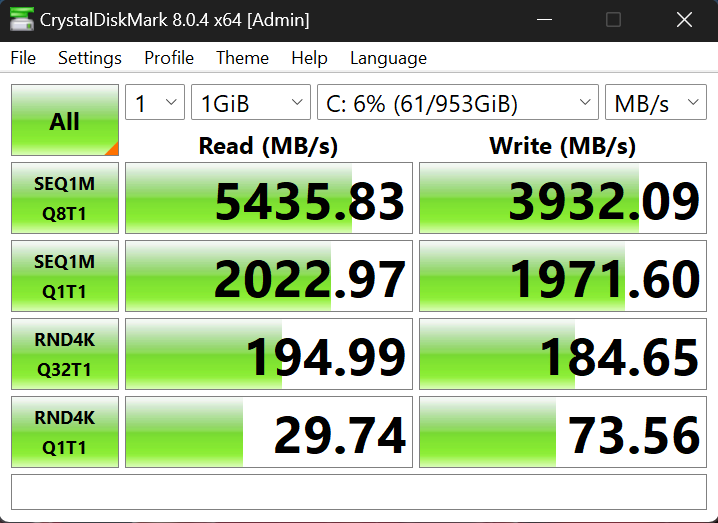© ROOT-NATION.com - Use of content is permitted with a backlink.
The Lenovo ThinkPad X1 Carbon Gen 11 is the flagship ultrabook of the company, which still sets the standard for business devices. Is it really so? The ThinkPad series can be called an icon of business laptop design. It is probably the only laptop series that cannot be confused with any other. It’s hard to believe that the lineup of Lenovo’s most prestigious business ultrabooks – the ThinkPad X1 Carbon – has been on the market for over 10 years.
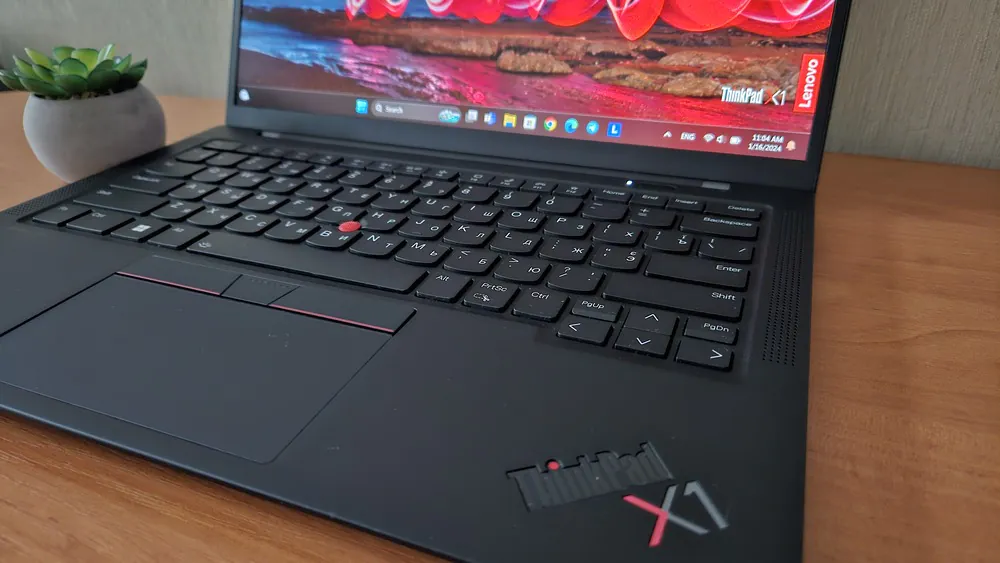
Despite sometimes appearing somewhat conservative in style, they always remain modern on the inside. This is well illustrated by the subject of our review – the slim, lightweight, yet, at the same time, robust Lenovo ThinkPad X1 Carbon 11th generation.
Read alsо: Lenovo Legion Pro 7i Gen 8 Review: a premium gaming laptop
What is interesting about Lenovo ThinkPad X1 Carbon Gen 11?
The Lenovo ThinkPad X1 Carbon Gen 11 mostly boasts excellent features – a compact form factor, lightweight design, good speakers, but some of its characteristics may be slightly overestimated. Compared to its predecessor, it is faster and has a better battery life, while the build quality, keyboard, touchpad, and screen remain identical. The latest model solidifies the ThinkPad X1 Carbon as a premium-class business device in the lineup.
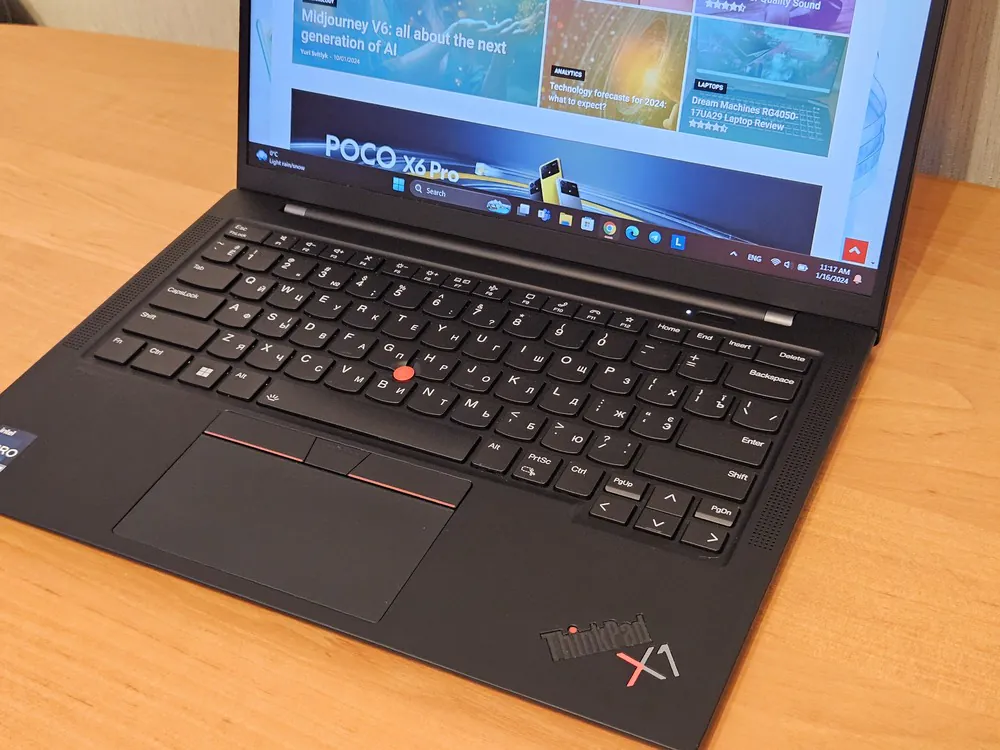
The 11th generation ThinkPad X1 Carbon doesn’t bring surprises or revolutionary updates compared to previous iterations, but users choose ThinkPad not for unexpected sensations. They choose ThinkPad for its reliability, security, and excellent build quality, including the industry-leading keyboard. The latest ThinkPad X1 Carbon continues to provide this, thanks in no small part to its robust carbon fiber chassis, which has now become more environmentally friendly while remaining user-friendly. The Lenovo ThinkPad lineup is a sort of gold standard in the corporate laptop segment on Windows, although it has many admirers beyond business environments.
The Lenovo ThinkPad X1 Carbon Gen 11 can confidently be called the best ultrabook for business. It features a powerful Intel Core i7 1355U 13th generation processor and is equipped with the integrated Intel Iris Xe graphics. All of this is complemented by 32GB of LPDDR5-5200 RAM and a modern KIOXIA (formerly Toshiba Memory) SSD with a PCI-E 4.0 4x interface and a capacity of 1TB. It’s a modern, powerful, yet lightweight and compact ultrabook suitable for business and beyond. The potential user of the ThinkPad X1 Carbon typically knows exactly what they need. In addition to the unquestionable advantages of the laptop, there is also a pleasant bonus in the form of Premium Support service for three years, including the option for on-site emergency repairs or temporary replacement of the laptop during service.
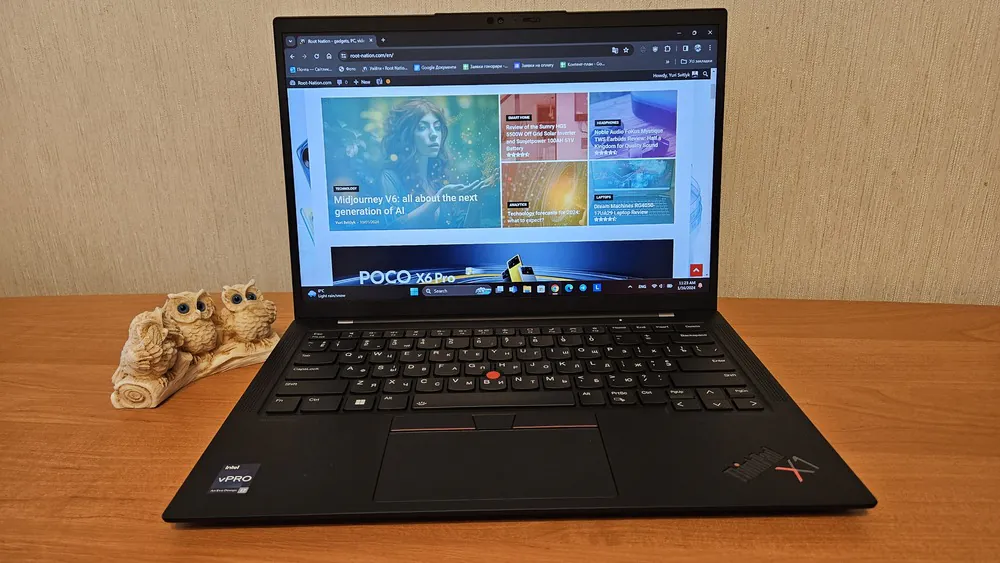
Certainly, such an ultrabook cannot be inexpensive. This is understandable when considering the positioning of the entire Lenovo ThinkPad X1 lineup. Yes, the tested version of the Lenovo ThinkPad X1 Carbon Gen 11 can be purchased in electronics stores with a price starting from $2600.
Technical specifications of Lenovo ThinkPad X1 Carbon Gen 11
- Display: matte IPS, 14″, 1920×1200 resolution, 16:10 aspect ratio, 400 nits brightness, 60 Hz frequency
- Processor: Intel Core i7-1365U (Raptor Lake, Intel 7), 10 cores (2P+8E), 12 threads, 1.9-5.2 GHz
- RAM: 32 GB LPDDR5-5200
- Storage: 1 TB PCIe4.0 x4 NVMe M.2
- Graphics: Intel Iris Xe
- Ports: 2 Thunderbolt 4 connectors (with DisplayPort and Power Delivery), two USB 3.2 Gen 2 Type-A, HDMI 2.0b, 3.5 mm audio jack, nanoSIM (optional)
- Wireless modules: Wi-Fi 6E, Bluetooth 5.1, LTE
- Camera: Full HD camera
- Audio: 4-speaker speaker system with Dolby Atmos support
- Keyboard and touchpad: island-type keys with liquid spill protection, 110 mm wide TrackPad glass touch panel, trackpoint
- Battery and charging: 57 Wh, 65 Watt power supply
- Dimensions: 315.60 × 222.50 × 15.36 mm
- Weight: 1.12 kg
What’s in the package?
The new Lenovo ThinkPad X1 Carbon Gen 11 comes in eco-friendly packaging without plastic. The shipping box is made only from cardboard and plant fibers, and inside, recycled materials from sugar cane and bamboo are used, which are 100% compostable.

Lenovo also noted that the laptop’s chassis is made using 90% recycled magnesium and 98% recycled plastic for the speakers. Recycled plastic is also found around the battery (25-30%) and in the USB Type-C adapter included in the power supply (90%). And I would like to emphasize that, although the device’s design has remained recognizable for some time (almost iconic), it is becoming increasingly environmentally friendly.
Included with the Lenovo ThinkPad X1 Carbon Gen 11 is only the slim 65W AC power adapter with a 3-prong USB Type-C connector. They also haven’t forgotten to include the instructions and the warranty card.
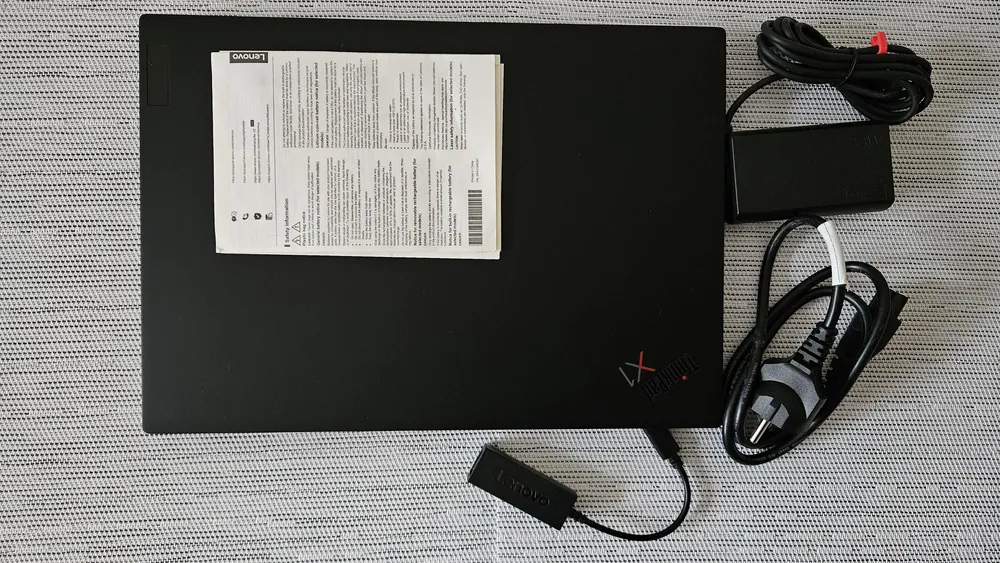
Literally from the first moment, you understand that you’re looking at an ultrabook from the famous ThinkPad series. It’s enough to simply open the lid and see the red TrackPoint button. Honestly, I’m always genuinely amazed at how popular the TrackPoint is among users. Everyone who owns a laptop from this series talks about the convenience of using this button. It has truly become the trademark of the ThinkPad series. In other aspects, it’s the same familiar shapes, the same keyboard, the same curvature of the lower part of the chassis. And this commands respect from enthusiasts.
Read also: Lenovo Yoga Pro 7 14IRH8 review: a powerful multimedia laptop
Recognizable design
The latest version of the 14-inch ThinkPad doesn’t surprise with unexpected stylistic decisions but offers what users are already accustomed to in this series. So, we have the typical black chassis, a black keyboard, and touchpad.
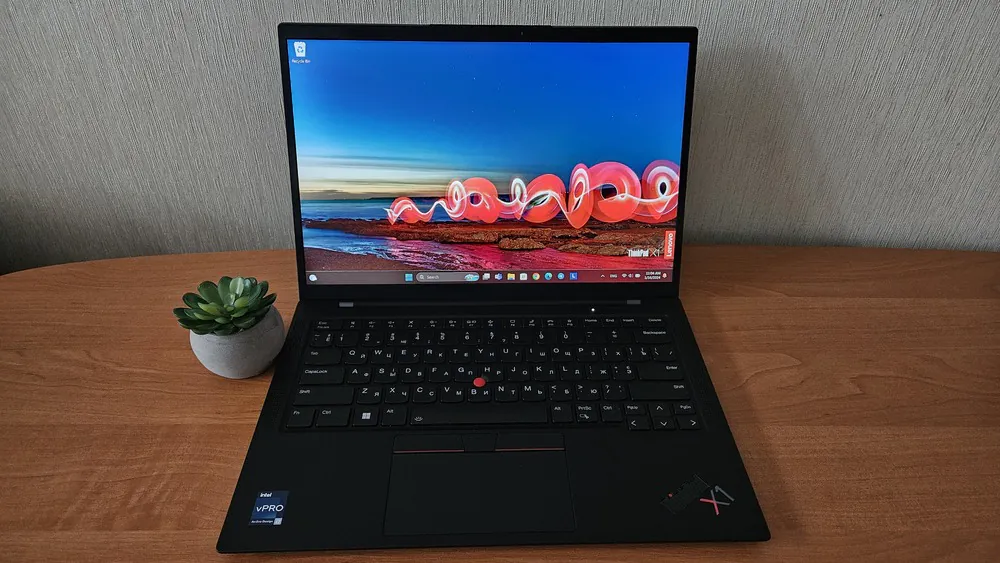
The external appearance of the ultrabook indicates that we are dealing with truly premium-class equipment. The ThinkPad X1 Carbon has always been a thin and lightweight laptop. Even the first representative of the family had a thickness of only 18 mm and weighed less than 1.4 kg, which made a huge impression in 2012. Today, there are laptops on the market with even thinner bodies, but the new release from Lenovo, as before, ranks among the thinnest and lightest devices. Its thickness is only 15 mm (a millimeter less than its predecessor), and it weighs just 1.12 kg, which, as before, is truly impressive.

The chassis is crafted from specially selected reinforced materials, ensuring it has the appropriate rigidity and strength. Magnesium alloy, used for the device’s body, and carbon fiber, the primary material for the hinge cover, play a significant role in reducing the laptop’s weight.
Both elements are additionally coated with a touch-friendly rubber polymer, making the grip of the laptop more comfortable. Moreover, this coating is resistant to dirt and scratches.
It’s also worth noting the excellent assembly of all components. Even when I lifted the computer by grabbing a corner, there was no sense that something might break any moment. There are no complaints about the chassis; nothing creaks or wobbles.
I can consider the entire structure of the new Lenovo ThinkPad X1 Carbon Gen 11 quite sturdy, although there is a noticeable flex in the area between the touchpad and the keyboard.
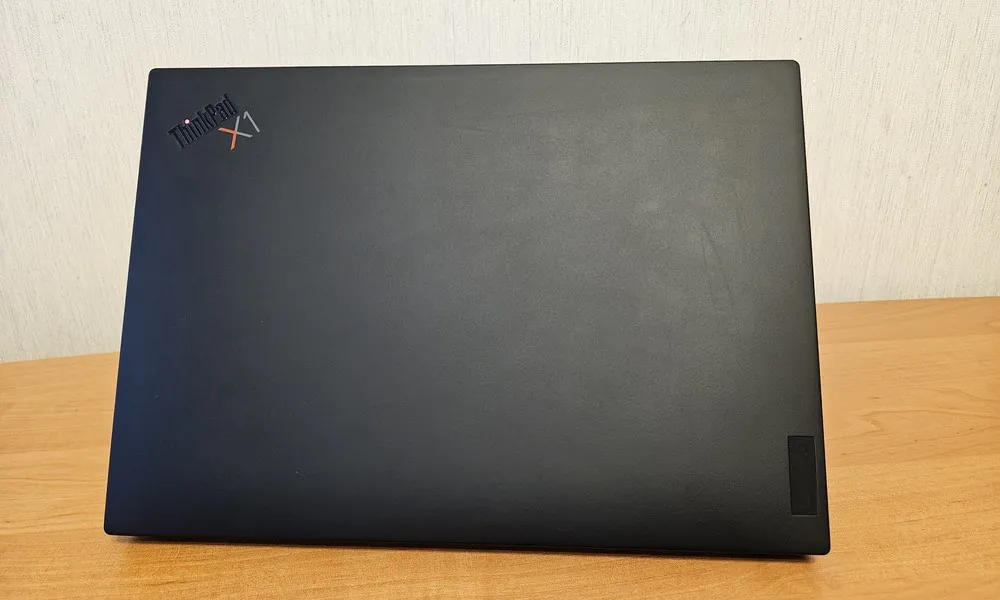 The lid is quite sturdy, and the two metal-plastic hinges excellently hold the screen in the chosen position. In the lower right corner of the lid, there is a small Lenovo logo, and in the upper left corner, there’s the ThinkPad logo with a red LED indicator. Simultaneously, the hinges work so smoothly that you don’t need to support the laptop with your other hand when opening it.
The lid is quite sturdy, and the two metal-plastic hinges excellently hold the screen in the chosen position. In the lower right corner of the lid, there is a small Lenovo logo, and in the upper left corner, there’s the ThinkPad logo with a red LED indicator. Simultaneously, the hinges work so smoothly that you don’t need to support the laptop with your other hand when opening it.
On the bottom part of the chassis, there are two rubber feet at the front and one wide foot at the back. Closer to the front of the laptop, there are two additional speakers. Near the hinges, you’ll find ventilation openings, although there aren’t many. But precisely beneath them are two small cooling fans.
Read also: Lenovo Legion 5 15IAH7H review: a powerful “legionnaire”
Ports and connectors
Regarding available ports, the set is the same as in the previous release of the Lenovo ThinkPad X1 Carbon. On the left side, we have a USB-C Thunderbolt 4 port (also used for power), another USB-C Thunderbolt 4, USB-A 3.2 Gen 1, and HDMI 2.0b. However, I would prefer a more powerful HDMI 2.1, but this seems like an acceptable compromise. I’ll remind you that the RJ-45 network port is available thanks to the included adapter, so the only potential addition could perhaps be a card reader.
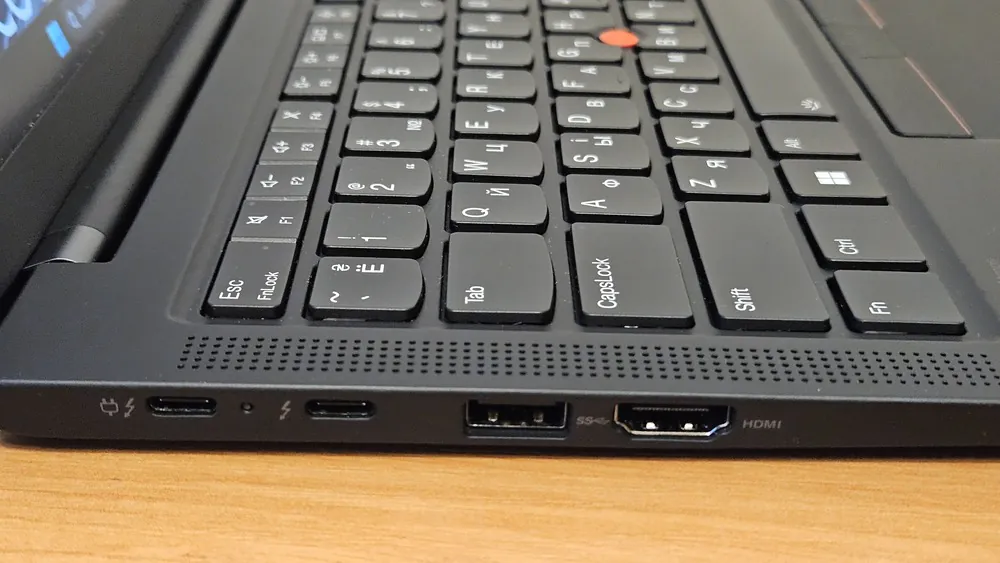
On the right side, there is a 3.5mm audio jack, a nanoSIM slot (configurations with and without a mobile modem are available), one USB Type-A 3.2 Gen 1, and a Kensington Nano Security Slot.
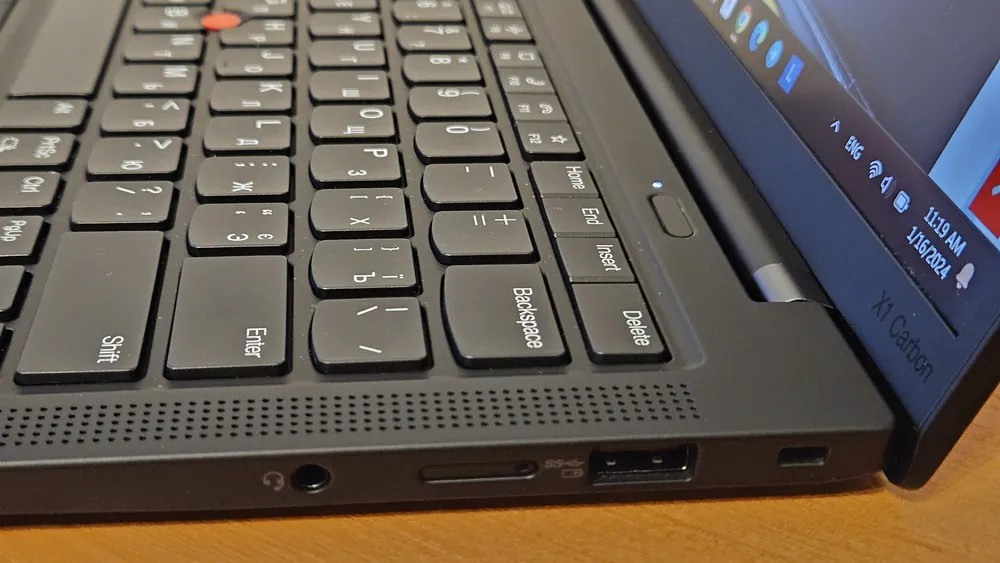
On the rear side, there’s nothing particularly interesting, just the hinge design. However, at the front, it gets a bit more interesting. In the location of the webcam, there’s a wide protrusion for convenient laptop opening, and on the sides, there are four microphones with neural network-based noise cancellation and support for Dolby Voice.
A set of ports that allows you to equip your laptop with the necessary tools for work (additional monitor, docking station, external drives) is always welcomed in an ultrabook.
I hope Lenovo has no plans to abandon full-size USB ports. The need for an adapter to connect a stylus or mouse is not a dream for owners of business-class laptops.
Read also: Lenovo ThinkBook Plus Gen 3 laptop review: When screens are enough
Keyboard and touchpad: the classics are timeless
Another advantage of the tested device is the profiled keyboard, providing maximum comfort during work. There are no surprises in this aspect. And that’s a very good thing.
I’ve written so many times about the ThinkPad keyboard that is a perfect fit for me that it’s starting to get a bit repetitive. But what can I do, it’s actually true. The perfect balance between key press softness, depth, and clear feedback—up until now, I haven’t encountered a keyboard that allows for such comfortable typing. The pleasant touch of the matte material used for the keycaps also contributes to this.
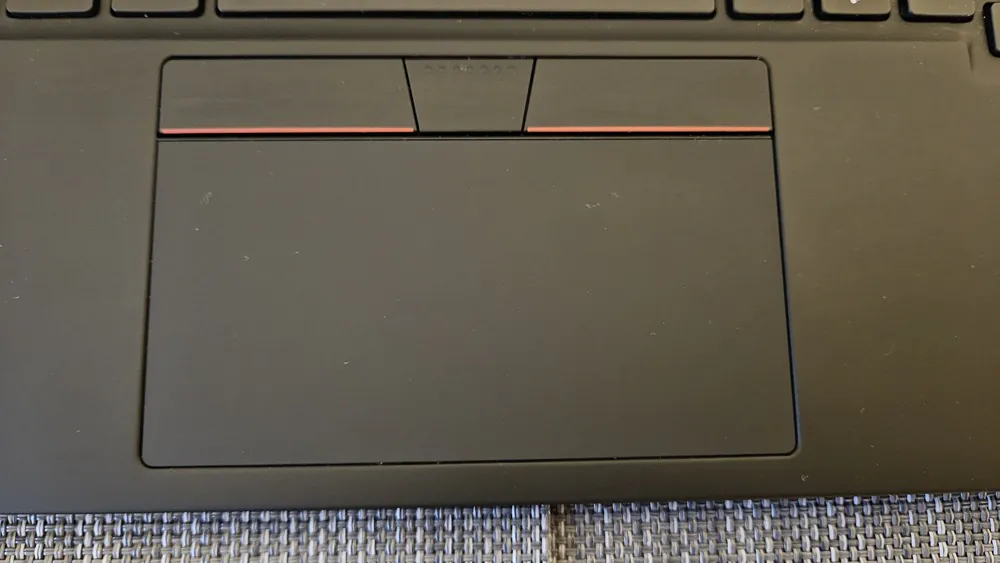
The touchpad has a fairly standard surface. It’s neither too large nor too small. There’s enough space to manipulate the cursor freely and use Windows gestures comfortably. The smooth surface doesn’t hinder finger movement, and on the matte finish, oily smudges are not easily formed. The touchpad buttons are integrated into the surface, their clicks are flat but firm enough not to worry about accidental presses.

However, in my opinion, the keys designated for the TrackPoint are too sensitive. Sometimes, while typing, I accidentally touched them, leading to unintended activations. But over time, you get used to it and begin to appreciate the beauty of using them.
What about the sound?
I get the impression that Lenovo has finally started paying a bit more attention to sound, at least in high-end hardware. For instance, the Lenovo Yoga Book 9i is one of the best-sounding laptops I’ve ever considered. Our reviewed device also joins this group closely. It boasts a total of four impressive speakers. Two are located above the keyboard, and two more can be found on the sides of the lower part of the device. Of course, everything is adorned with the Dolby Atmos logo.
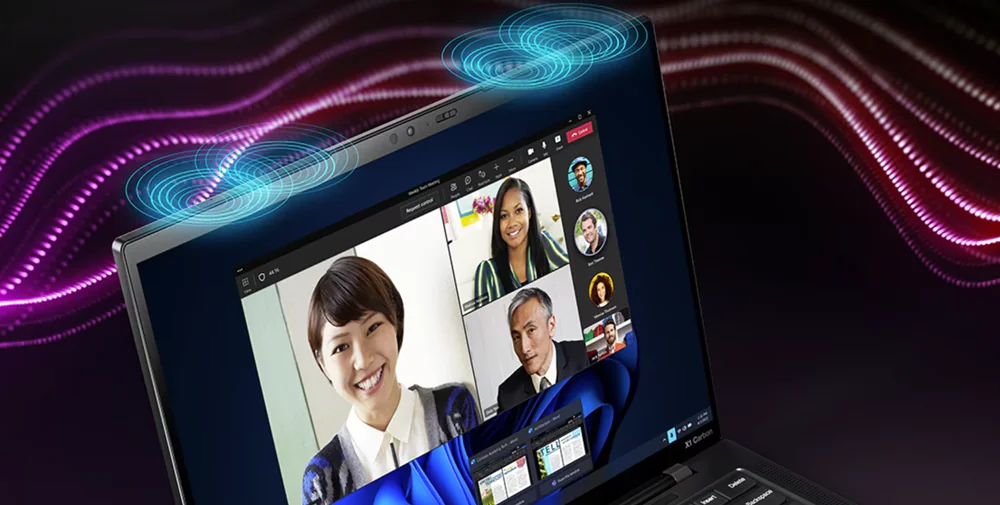
It turns out that the difference in sound in this ultrabook compared to previous generations is noticeable from the first note. The sound is so loud that even at 85% volume, it’s enough to fill a large room. However, even at maximum volume, you won’t hear membrane overload, crackling, or any other sound distortions. The reproduced music, by general consensus, is deemed too bright and cold, lacking a bit more warmth in the tones. Though the bass is quite well-defined (for laptop speakers without a subwoofer, of course), the equalizer can handle this. Even the simplest one, found in the Dolby Atmos Speaker System application responsible for sound management.
Read alsо: Realme Book Prime review: is the manufacturer’s first laptop a success?
Safety comes first
Any business device owner always requires maximum security for access and personal data. After all, in business, this is crucial and highly demanded.
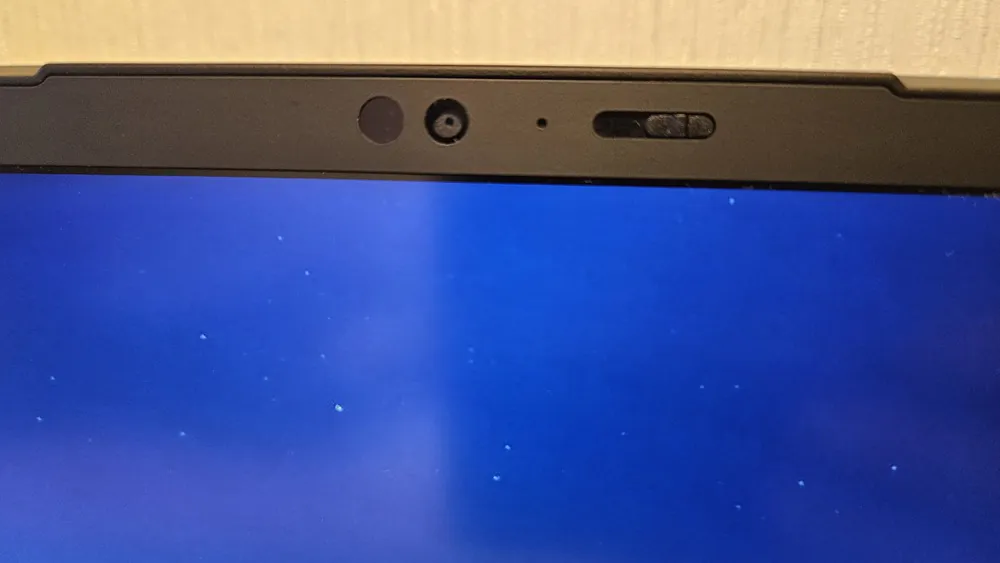
In this regard, you won’t have any questions about the Lenovo ThinkPad X1 Carbon Gen 11. The Lenovo business laptop features a hybrid setup with a webcam, an IR camera for facial recognition, and a physical ThinkShutter cover. Next to the camera, there is an indicator for its operation, as well as an infrared camera used for identifying the laptop owner. If needed, you can close the webcam with the shutter. The camera itself has a FullHD resolution and supports Windows Hello functionality.
Read also: ASUS ROG STRIX SCAR 17 G733PY-LL020X gaming laptop review
High-quality screen
Ultrabooks of this series have always been famous for their high-quality matrices. And Lenovo continues this tradition. The device guarantees high-quality, realistic images that should satisfy even the most demanding professionals.
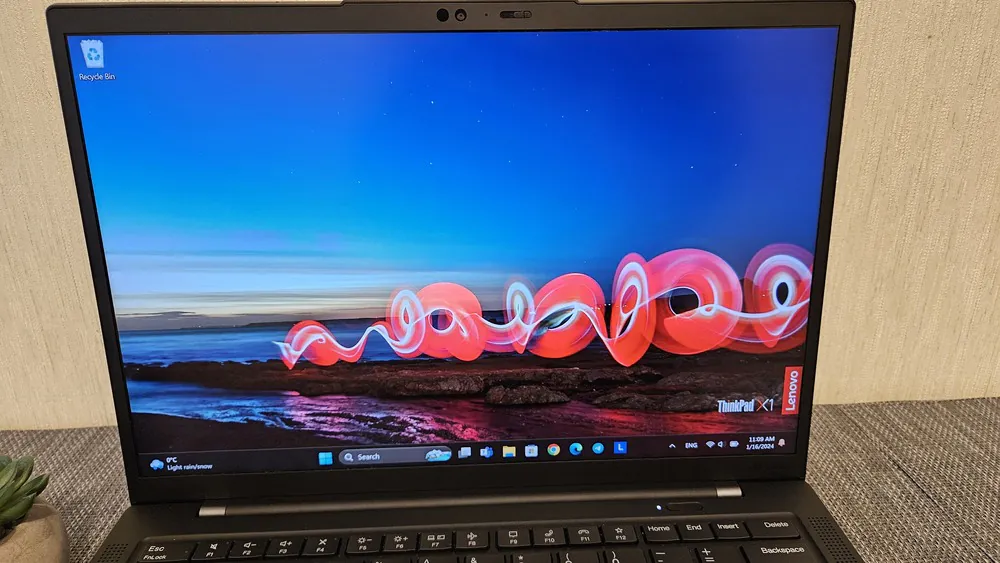
It’s worth noting that the Lenovo ThinkPad X1 Carbon Gen 11 comes with several display options. The most interesting variant is the touchscreen OLED 2880×1800, with the option of the PrivacyGuard screen filter. This display provides incredibly vibrant, realistic colors. Every aspect of the image is at a high level, ensuring a comfortable user experience with the laptop.
The manufacturer also offers laptop versions with IPS WQHD and IPS Full HD screens, referring to models with reduced power consumption, Privacy Guard protection that prevents unauthorized viewing of displayed content, and touchscreen functionality. Each screen is adequately protected against direct sunlight, ensuring that the visibility of the displayed content remains at a high level.
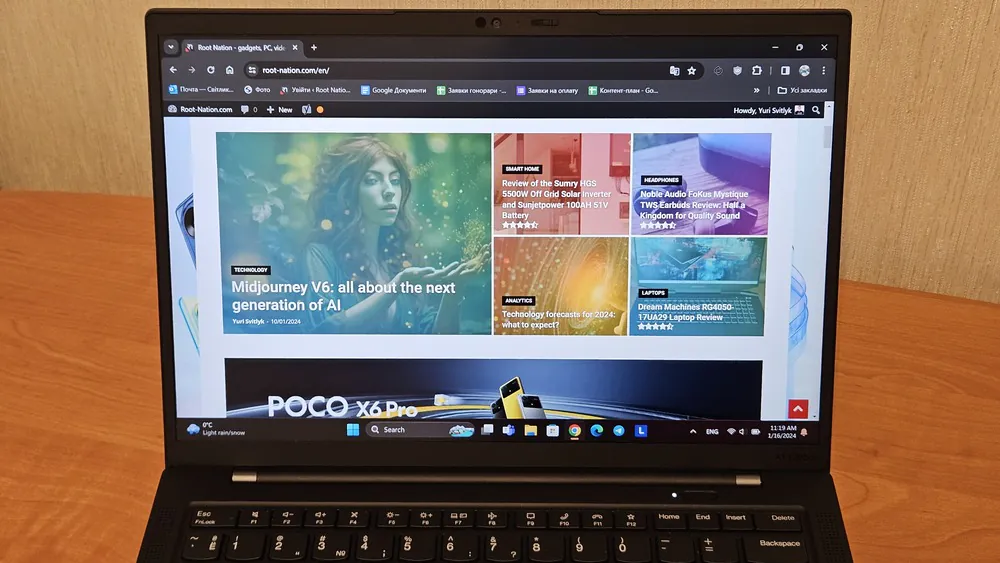 In our case, there was a “regular” IPS panel with a Full HD resolution of 1920×1080 pixels, featuring an anti-glare coating and a 16:10 aspect ratio. The IPS panel is sharp, but it lacks a bit in black color depth and, consequently, deeper contrast.
In our case, there was a “regular” IPS panel with a Full HD resolution of 1920×1080 pixels, featuring an anti-glare coating and a 16:10 aspect ratio. The IPS panel is sharp, but it lacks a bit in black color depth and, consequently, deeper contrast.
The test results did not deviate significantly from the manufacturer’s stated values (obtained 1118:1 contrast ratio compared to the stated 1200:1, and 395 nits brightness compared to the stated 400 nits). The panel looks very good in terms of color reproduction. It’s worth noting the 96% coverage of the sRGB color gamut.
Matrix parameters:
- brightness: 395 cd/m²
- contrast ratio: 1118:1
- black: 0.33 cd/m²
- sRGB palette: 96%
- AdobeRGB palette: 78%
While there are some nuances, they might be noticed by those using high-quality screens or monitors. We’re talking about the screen response time, and this could pose some issues. Nevertheless, we hope that this problem is observed only in models with such IPS matrices. However, motion trails are still quite noticeable. While it’s not very apparent during regular office tasks, you immediately notice that the screen lags behind in gaming scenarios.
Read alsо: Acer Swift Go 14 (SFG14-71) review: laptop for life on the go
Sufficient performance
Lenovo has started incorporating Intel U and P series processors into the latest generation ThinkPad X1 Carbon and ThinkPad X1 Yoga laptops. The subject of my review is equipped with the Intel Core i7-1355U chip. This processor is part of the thirteenth-generation Intel U series, designed for laptops, ensuring high performance without significantly increasing power consumption. It proves to be quite robust, particularly noticeable when making a leap from previous generations of the series.
This is a modern processor with 10 cores (two productive and eight energy-efficient), 12 threads, and a maximum frequency of 5 GHz. These processors are available with or without vPRO, depending on your requirements. It comes with a platform for remote administration and management with a discrete dTPM module. The clock frequency of productive cores ranges from 1.8 to 5.2 GHz, while the energy-efficient ones range from 1.3 to 3.9 GHz. The cache memory is 12 MB.
Comparing the U and P series processors is not overly complicated. These latest chips are designed to enhance the performance of mobile devices, with a TDP of 28W that can be increased to 64W if needed. The older U series chip in my review device operates with a lower 15W TDP, which can reach 55W. While U series processors may not provide such high performance, they consume less energy and generate lower temperatures. This is particularly important for such a thin laptop, often used for on-the-go work.
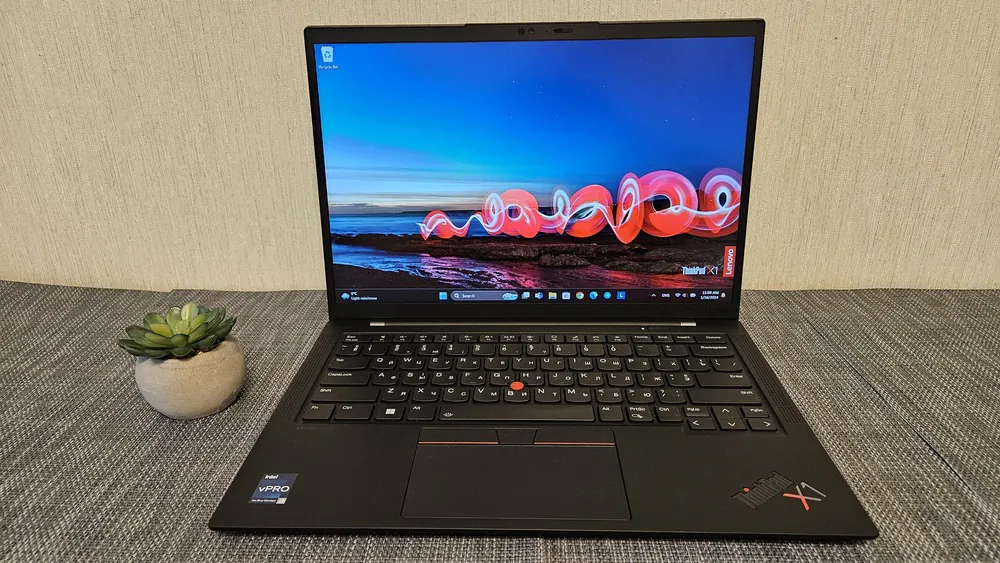
In reality, the difference is not very noticeable. I could use Photoshop, Word, Edge (with a large number of open tabs), Spotify, and much more simultaneously without any slowdown, and I never felt the laptop heating up. You will hear the fans, but they will never be louder than a whisper.
The new Lenovo model, while not a multimedia device, can display more than just documents and spreadsheets, thanks to its pleasant audio and 4K HDR displays. When it comes to 4K movies, there are no issues.
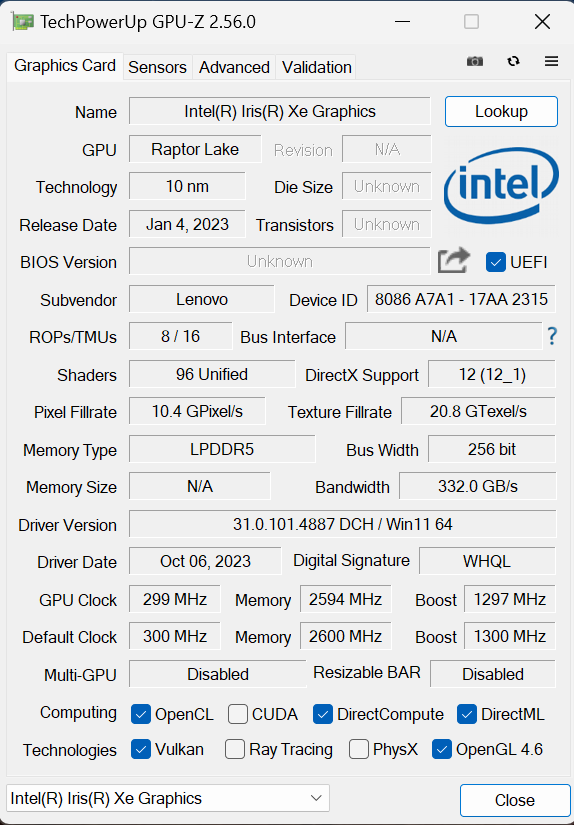 The integrated Intel Iris Xe handles them without any issues. This adapter comes with 96 execution units, and the maximum frequency can reach 1300 MHz. However, more demanding multimedia tasks (such as 3D games) and complex projects require something more powerful. In other words, you would need a discrete graphics card, which you won’t find in any ultrabook configuration. If someone wants to upgrade, they can opt for an eGPU station that connects to the laptop via Thunderbolt 4, allowing you to attach a desktop graphics card. The processor, by general consensus, may become a so-called “bottleneck,” preventing the card from fully spreading its wings, but there would still be a significant boost in graphics performance. The extent of this increase depends on the chosen graphics card.
The integrated Intel Iris Xe handles them without any issues. This adapter comes with 96 execution units, and the maximum frequency can reach 1300 MHz. However, more demanding multimedia tasks (such as 3D games) and complex projects require something more powerful. In other words, you would need a discrete graphics card, which you won’t find in any ultrabook configuration. If someone wants to upgrade, they can opt for an eGPU station that connects to the laptop via Thunderbolt 4, allowing you to attach a desktop graphics card. The processor, by general consensus, may become a so-called “bottleneck,” preventing the card from fully spreading its wings, but there would still be a significant boost in graphics performance. The extent of this increase depends on the chosen graphics card.
During the purchase, you also need to consider the required amount of memory. The latest ThinkPad X1 Carbon Gen 11 doesn’t have SODIMM slots, meaning the RAM is soldered onto the motherboard (LPDDR5). Therefore, you won’t be able to add or replace the RAM. The test model was equipped with 32 GB of LPDDR5-5600 memory (there’s also an option for 16 GB), and it was entirely sufficient for productive work.
Wireless interfaces are also modern: Wi-Fi 6E (802.11ax) and Bluetooth 5.1. Some configurations also offer a mobile modem and NFC support. The laptop complies with the Intel Evo program, which has specific requirements for characteristics.
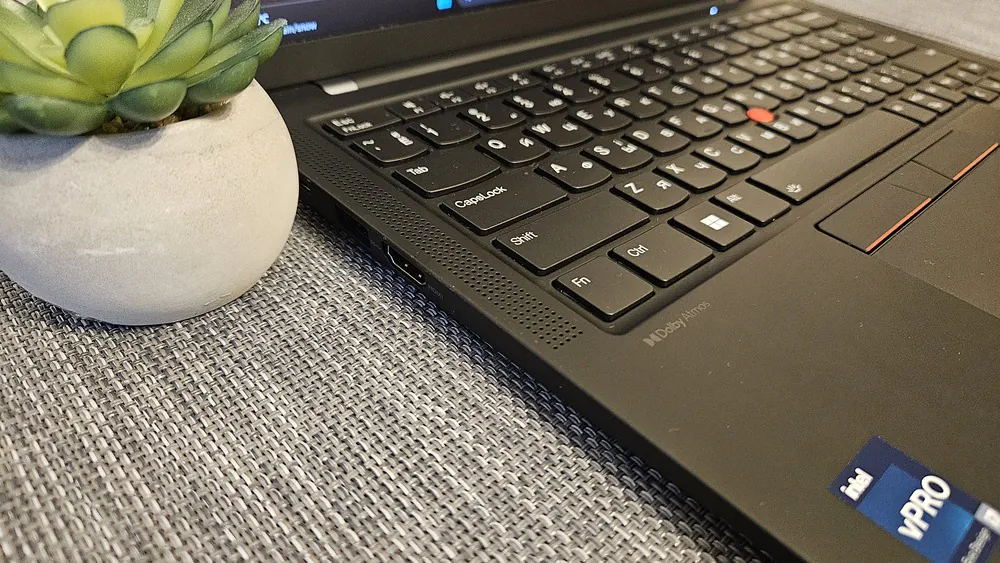
You should understand that you are dealing with a business laptop designed for specific usage scenarios and corresponding productivity requirements. The overall performance is sufficient for simultaneous work with numerous documents, a browser with multiple tabs, basic image processing, video conferences, and email. In other words, it has more than enough capability for everyday office tasks. I even tried playing some lightweight computer games during breaks. It can handle something not very demanding or graphically intensive. For instance, I managed to run Tomb Raider at medium settings and 1920×1200, achieving 55-60 FPS.
In benchmarks, the laptop exhibits quite high performance scores in system and processor tests. In graphics tests, the scores are rather modest, which is entirely expected.
Completing the picture is a fairly fast and high-quality 1 TB XG8 SSD storage from KIOXIA (formerly Toshiba Memory) with a PCI-E 4.0 4x interface. The claimed reading speed is up to 7000 MB/s, and the writing speed is up to 5600 MB/s.
 Such disk parameters provide not only very fast system startup and almost instantaneous opening of applications but also efficient copying and moving of even large files. The disk is suitable for a high-end computer, leaving no doubts about its performance.
Such disk parameters provide not only very fast system startup and almost instantaneous opening of applications but also efficient copying and moving of even large files. The disk is suitable for a high-end computer, leaving no doubts about its performance.
Read also:
- Switching to Apple MacBook Air with M2 processor: review and my impressions
- ASUS ExpertBook B9 (B9403CVA) laptop review: lightweight, stylish, productive
Temperature and fan noise
The 15mm thick chassis, a sufficiently powerful processor (for a 15W TDP), and two miniature fans cooling the components may raise concerns about noise. As it turns out, these concerns are not unfounded, but they are not critical either. Regarding the cooling system’s performance, the Lenovo ThinkPad X1 Carbon Gen 11 handled it excellently.
The everyday operation seemed to be easy for the processor, so the laptop remained silent. Only when the processor kicked into high gear did the fan come to life with a gentle noise, easily drowned out by ambient sounds. In settings like a cafe or during a meeting, the fan noise of your device is unlikely to attract attention from those around you.
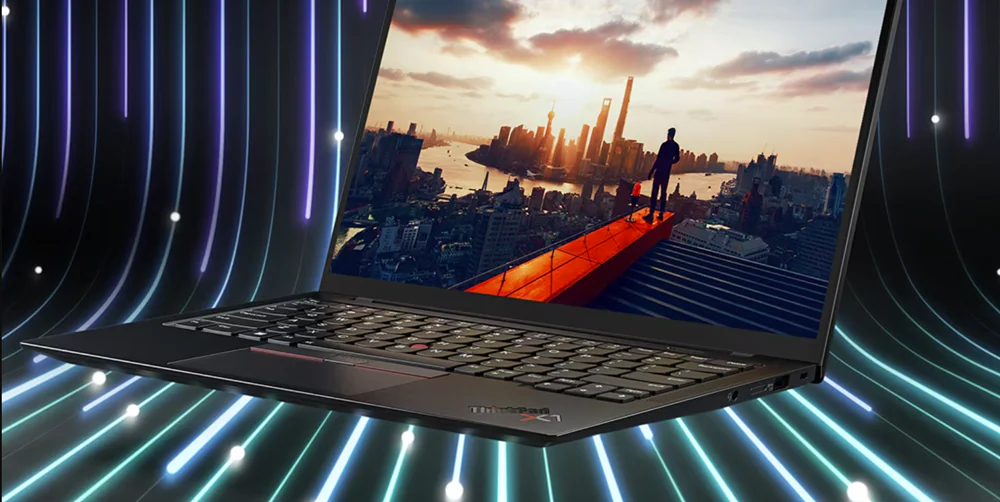
The temperature map of the chassis, especially its bottom part, seemed a bit less favorable. Under load in the middle area of the bottom of the chassis, the temperature can reach 55-57°C. For a laptop that you will likely have to work with on your lap from time to time, these values are too high. Sometimes, this can cause significant discomfort. Of course, this occurs because in such a position, the laptop covers the small openings through which the cooling system draws in air from the outside.

But, after all, I can’t imagine anyone buying the ThinkPad X1 Carbon to download high-resolution movies or run other demanding applications on it for an extended period with the computer on their lap. Typically, such a laptop is positioned on the desk of a business professional or a mid-level manager. In this case, the heating of the chassis is unlikely to affect its operation.
Read also:
- Acer Nitro 5 AN515-47 2023 Laptop Review
- Acer Swift Go 14 (SFG14-71) review: laptop for life on the go
Battery life
In terms of battery life, it’s always crucial for a business-class device to comfortably last throughout the entire workday. I would note that power management on the new ThinkPad X1 Carbon Gen 11 is significantly better than its predecessor. The eleventh generation comes with a 57 Wh battery. Despite the more powerful processor under the hood, the battery life will pleasantly surprise you. It ensures more than enough energy for a full workday, with around 35% remaining at the end of the day. Undoubtedly, this speaks to the excellent energy efficiency of our review subject.

The office work simulation only consumed the battery in 8.5 hours. If we use the laptop more conservatively, focusing on tasks that don’t require excessive energy consumption, we can expect up to 10 hours of autonomous operation. It’s indeed a durable and powerful machine for business professionals.
It’s worth noting that the Lenovo ThinkPad X1 Carbon Gen 11 also features support for Rapid Charge. The manufacturer claims that you can charge the battery up to 80% in one hour, and a full charge takes approximately 1.5 hours. These are quite impressive figures for a business laptop of this class.
Should I buy the ThinkPad X1 Carbon Gen 11?
At first, I wanted to compare the Lenovo device with something else, but then I realized that, for the most part, these would be the same ThinkPad series ultrabooks, just with different orientations or from different generations. One could mention the HP EliteBook 1000 series, HP Spectre, or Dell XPS, but they have slightly different focuses. Therefore, we won’t delve into discussing competitors.
The new Lenovo ThinkPad X1 Carbon Gen 11 once again reaffirms its belonging to the rather exclusive group of premium-class devices. It has almost everything that a device from this segment needs. There’s an elegant chassis representing a sturdy and lightweight construction made of high-quality materials, a recognizable design, and a top-notch display with a powerful 13th-generation processor in the top configuration. Add to this a wide range of security and connectivity options and a long-lasting battery. The ultrabook has finally received a worthy audio system, which has been notably absent from devices in this segment. As for the keyboard, touchpad, and the remarkable TrackPoint, I won’t even dwell on them, as they have long become the hallmark of business laptops in the ThinkPad series.
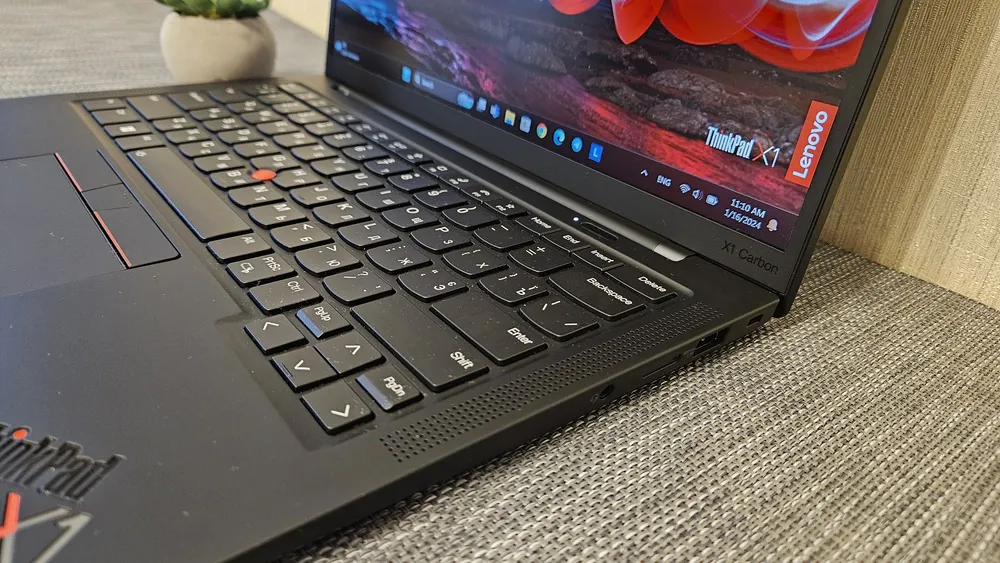
The laptop also pleasantly surprised in terms of available configurations and overall performance. Some may be disappointed by the presence of soldered RAM, but it’s essential to consider that this situation is quite common with ultrabooks. The absence of an option with a discrete graphics card might be seen as a drawback by some, but this device serves an entirely different purpose.
The processor from the Intel Raptor Lake family finally showcased its capabilities, and I was pleasantly surprised by the performance it achieved in harmony with the KIOXIA SSD. However, it’s unfortunate that the high processor performance clearly affected the temperature readings on the laptop’s surface.
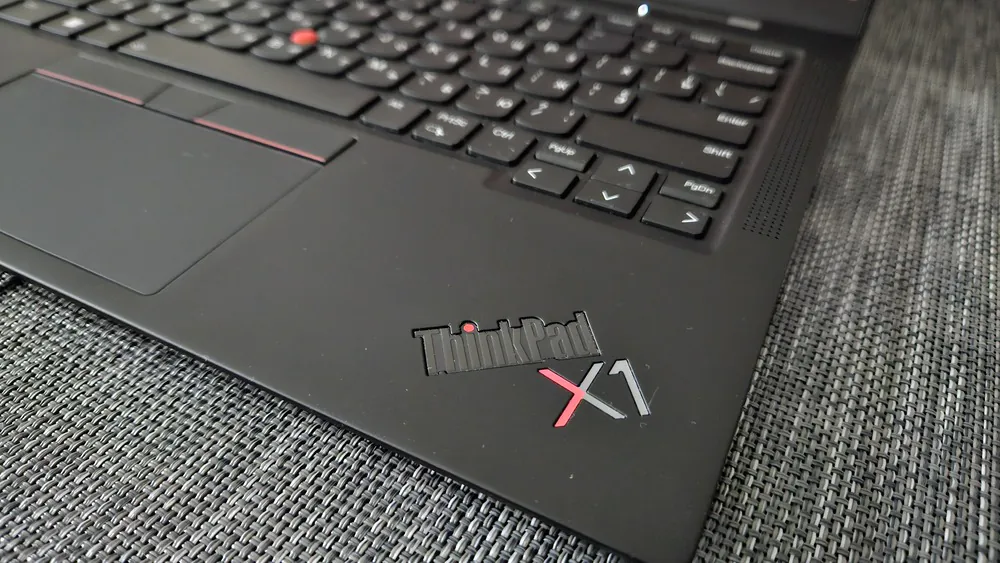
In conclusion, in my opinion, the tested Lenovo ThinkPad X1 Carbon Gen 11 can be considered one of the best representatives of this series. It will undoubtedly take a worthy place on the desk of a modern top manager of the company and beyond.
Read also:
- Midjourney V6: all about the next generation of AI
- Human Brain Project: Attempt to imitate the human brain




